
Harness





Harness




Editor:
Sarah Peiper
Contributors:
Marissa Bankert
Wendy Christie
Jason LaMonica
Anthony Milia
Mark Phelps
Tim Saddoris
Louise Scott
Ted Sherritt
Ed Young
Proofreader:
Marsha Jo Scott
Design: V2 Marketing & Management
Printing and Distribution:
LSC Communications
Photos in this publication may not depict proper safety procedures for creative purposes. ISFA and Countertops & Architectural Surfaces magazine support the use of proper safety procedures in all cases and urge readers to take steps to institute such procedures.
Photography/graphics provided by:
ActionFlow
Caesarstone
Wendy Christie
Cosentino
Durat
Countertops & Architectural Surfaces (ISSN 2372-983X) is published quarterly by the International Surface Fabricators Association (ISFA), with a fifth edition, a Buyers Guide, publishing in October.
Individual copies of Countertops & Architectural Surfaces magazine are available at the nonmember newsstand price of $14.95. Countertops & Architectural Surfaces magazine is also available by annual subscription (five issues) for $30.00. ISFA members receive a complimentary annual subscription with every membership renewal. Special rates and charges apply for orders outside of the United States. To subscribe, call (888) 599-ISFA.
For change of address, please include old label with new information, including both old and new ZIP codes. Allow 3-6 weeks for address change to take effect.
Countertops & Architectural Surfaces magazine is proudly printed in the United States of America. Copyright © International Surface Fabricators Association 2024. All rights reserved. No part of this publication may be reprinted or otherwise reproduced without the publisher’s written consent.
Countertops & Architectural Surfaces magazine and the International Surface Fabricators Association assume no responsibility for unsolicited manuscripts or photographs. Materials will be returned only if accompanied by a stamped, self-addressed envelope.
Opinions expressed by contributors in this magazine are not necessarily the opinions of Countertops & Architectural Surfaces magazine or the International Surface Fabricators Association, but rather those of the individual writers.
Fabricator’s Choice
Flexijet
FreePower
GMD Surfaces
Integra Adhesives
Jason LaMonica
Laser Products Industries
LX Hausys
Anthony Milia
Moraware
Neolith
Park Industries
Mark Phelps
Prodim Systems
Tim Saddoris
Slabsmith
SlabWare
StoneGrid
Vadara Quartz Surfaces
Wetwall
Ed Young
POSTMASTER: Send address changes to:
LSC Communications
c/o Countertops & Architectural Surfaces magazine 3401 Heartland Drive Liberty, MO 64068
THE OFFICIAL PUBLICATION OF THE INTERNATIONAL SURFACE FABRICATORS ASSOCIATION



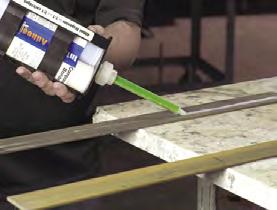
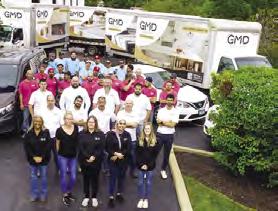
24 How Artificial Intelligence Can Improve Your Fabrication Business
Don’t think you have the technical chops to harness artificial intelligence? Take a deep dive into how AI is easier to use than you think.
28 Workflow Wonders: Software
Innovations for Surface Fabricators
Read about a dozen of the most popular software solutions, designed to streamline processes, monitor material inventory, track jobs, review metrics and provide a richer experience for your customers.
34 Choosing the Right Adhesives for Kitchen & Bathroom Installations
When it comes to countertops, selecting the right adhesive and sealant for each application is crucial to ensuring a durable, long- lasting, aesthetically pleasing finish.
38 ISFA Fabricator Profile: GMD Surfaces
Since 2007, GMD Surfaces has become one of Chicago’s premier surface fabricators. Learn how Owner Omar Chahin integrates cutting-edge technology and strict quality control measures to ensure meticulous craftsmanship.
44 Improving Work-Life Balance
in Blue Collar Industries
The skilled labor pool isn’t as shallow as you think, but finding and retaining employees requires a shift in mentality if you want to stay afloat.


Photo
Bonding a Variety of Surfaces with Integra Adhesives.
Integra Adhesives manufactures a complete range of color-matched seaming and assembly adhesives, as well as a range of color-matched sealants for the surfacing industry. Whether you’re bonding surfacing materials like solid surface or porcelain, assembly components like wood, fiberglass or steel, or tackling an outdoor project, Integra Adhesives offers time-tested, reliable products to complete the job. Integra’s seaming adhesives not only save time and money but also provide stronger joints, perfect for the latest thinner sheets. Additionally, they ensure a safer workplace and customer environment by being free of styrene and isocyanates. To learn more, visit www.integra-adhesives.com.
A special thanks to FloForm Victoria and VI Granite & Quartz Nanaimo for their assistance with sourcing the materials that appear in this issue’s cover image.


46 Onboarding the Next Generation:
A New Approach to Employee Orientation
Handling the new generation of employees requires a different approach to onboarding an approach that focuses on engagement right from the start.
8 Editor’s Note
10 Calendar of Events
12 Industry News
14 Sales & Marketing
36 Sustainability Matters
48 Perspectives: Marissa Bankert
49 ISFA News
52 ISFA Associate Member Directory
56 Product News
58 Perspectives: Ted Sherritt



Artificial intelligence (AI) has rapidly emerged as one of the most transformative technologies of the 21st century. While its impact is widely felt across almost all sectors, its dual nature as both a threat and a boon cannot be overlooked. As it continues to evolve, AI is reshaping industries in unprecedented ways, creating challenges for some while offering new opportunities for others.
AI’s capability to perform tasks with high precision and efficiency has led to significant disruption in several traditional industries. One of the most affected sectors is manufacturing. The advent of AI-powered automation and robotics has revolutionized production processes, replacing human labor with machines in many instances. This shift has resulted in job losses, particularly for low-skilled workers whose roles are increasingly being performed by robots. For example, assembly line jobs that once required human intervention are now managed by AI-driven systems that can work around the clock without fatigue.
While AI poses a threat to certain industries, it simultaneously elevates others, particularly the construction and remodeling industry. AI technologies enhance planning, project management and safety. Drones and AI-powered software are used to survey sites, monitor progress and ensure adherence to safety protocols. AI’s integration into the fabrication industry has also brought about a paradigm shift in worker safety. Through predictive maintenance, improved ergonomics, environmental monitoring, automation of hazardous tasks, enhanced training and real-time analytics, AI is making our shops safer and more efficient. On the business side, it helps us improve communications, manage employees, track jobs and more (page 24). Doesn’t sound like a threat to me.
That’s because the core of the work still relies heavily on skilled humans. As AI takes over administrative and planning tasks or automates fabrication, there’s still a skilled worker behind the machines, who now can focus on the craftsmanship and technical aspects of their trades, leading to higher-quality outcomes and increased demand for their expertise.
That said, the dichotomy of AI as both a disruptor and
an enhancer necessitates a strategic approach to workforce development. Industries facing disruption must invest in retraining and upskilling their employees. Governments and educational institutions play a crucial role in this transition by providing accessible training programs that equip workers with the skills needed for emerging roles in the AI-driven economy. This issue’s fabricator profile features GMD Surfaces of Mokena, Illinois (page 38). Owner Omar Chahin has leveraged automation, AI and a group of industrial engineering students to help him harness the power of technology to improve his workflow. Pretty smart.
AI’s impact on industries is a complex interplay of threats and opportunities. While some sectors experience displacement and disruption, others, particularly skilled trades, see growth and elevation. The key to navigating this transformation lies in adaptability, continuous learning and strategic workforce development. As AI continues to advance, embracing its potential while mitigating its challenges will determine the future landscape. Through a balanced approach, industries can harness AI’s power to enhance human capabilities, drive innovation and create a more resilient and dynamic industry.
As a writer, I am not threatened by AI. I often use ChatGPT, and I’m not ashamed to admit it. There’s no pride or authority lost in working smarter, not harder. I use it as a sounding board, a fact finder that helps me capture general information that inspires me down a creative path. I bounce ideas off it, spin phrases, and ask for rewrites to find more creative hooks. I do this so I can focus on the tasks that only I can complete.
For example, I asked it to “Write 10 headlines about a software and technology feature for fabricators” (page 28). In 3.5 seconds, it spit out 10 clever(ish) headlines back at me. None of them was what I wanted, but the results helped me look at different word usage and phrasing that could have had me brainstorming all afternoon. It’s a tool in my arsenal that fosters efficiency, but it cannot fully replace what I produce, which still requires the unique perspective and context I have that comes from living and breathing in this industry.

International Manufacturing Technology Show September 9-14
Chicago www.imts.com
Submit your event for consideration in Calendar of Events by emailing Editor Sarah Peiper, Sarah@ISFAnow.org.
ISFA Fabricator Forum September 11-12 St. Louis www.ISFAnow.org
ISFA MemberConnect Meeting September 19 Virtual www.ISFAnow.org
Ohio Stone Summit: Dynamic Intentionality September 19
MSI Surfaces Columbus, Ohio www.naturalstoneinstitute.com
Cersaie September 23-27 Bologna, Italy www.cersaie.it
Marmomac September 24-27 Verona, Italy www.marmomac.com
ISFA Porcelain Fabrication Training September 26-27 Austin, Texas www.ISFAnow.org
Digital Stoneworking Expo by Park Industries October 4 Honolulu www.parkindustries.com/dse
POLYCON 2024 October 7-9 Springfield, Massachusetts www.theicpa.com
Washington Stone Summit: Fabricator Town Hall October 10
MSI Surfaces Kent, Washington www.naturalstoneinstitute.com
Chicago Build Expo October 22-23 Chicago www.chicagobuildexpo.com
Kitchen + Bath Canada 2024 October 22-24
Mississauga, Ontario www.kbcexpo.com
Solid Surface Fabrication Training October 22-23 Boston www.ISFAnow.org
BACA BASH by BACA Systems November 6-7
Orion Township, Michigan www.bacasystems.com
Texas Stone Summit: Know Your Business November 7 Arizona Tile Dallas www.naturalstoneinstitute.com
ISFA Annual Conference November 6-8 Miami www.ISFAnow.org
ISFA MemberConnect Meeting November 14 Virtual www.ISFAnow.org
The International Surface Event (TISE) January 28-30 Las Vegas www.intlsurfaceevent.com
Marmomac Brazil February 18-20
San Paulo, Brazil www.marmomacbrazil.com.br/en/
Kitchen & Bath Industry Show (KBIS) February 25-27
Las Vegas www.kbis.com
International Builders Show (IBS) February 25-27
Las Vegas www.buildersshow.com
Xiamen Stone Fair March 16-19
Xiamen, China www.stonefair.org.cn
Coverings 2025 April 29-May 2 Orlando www.coverings.com
HD Expo+Conference May 6-8
Las Vegas www.hdexpo.hospitalitydesign.com
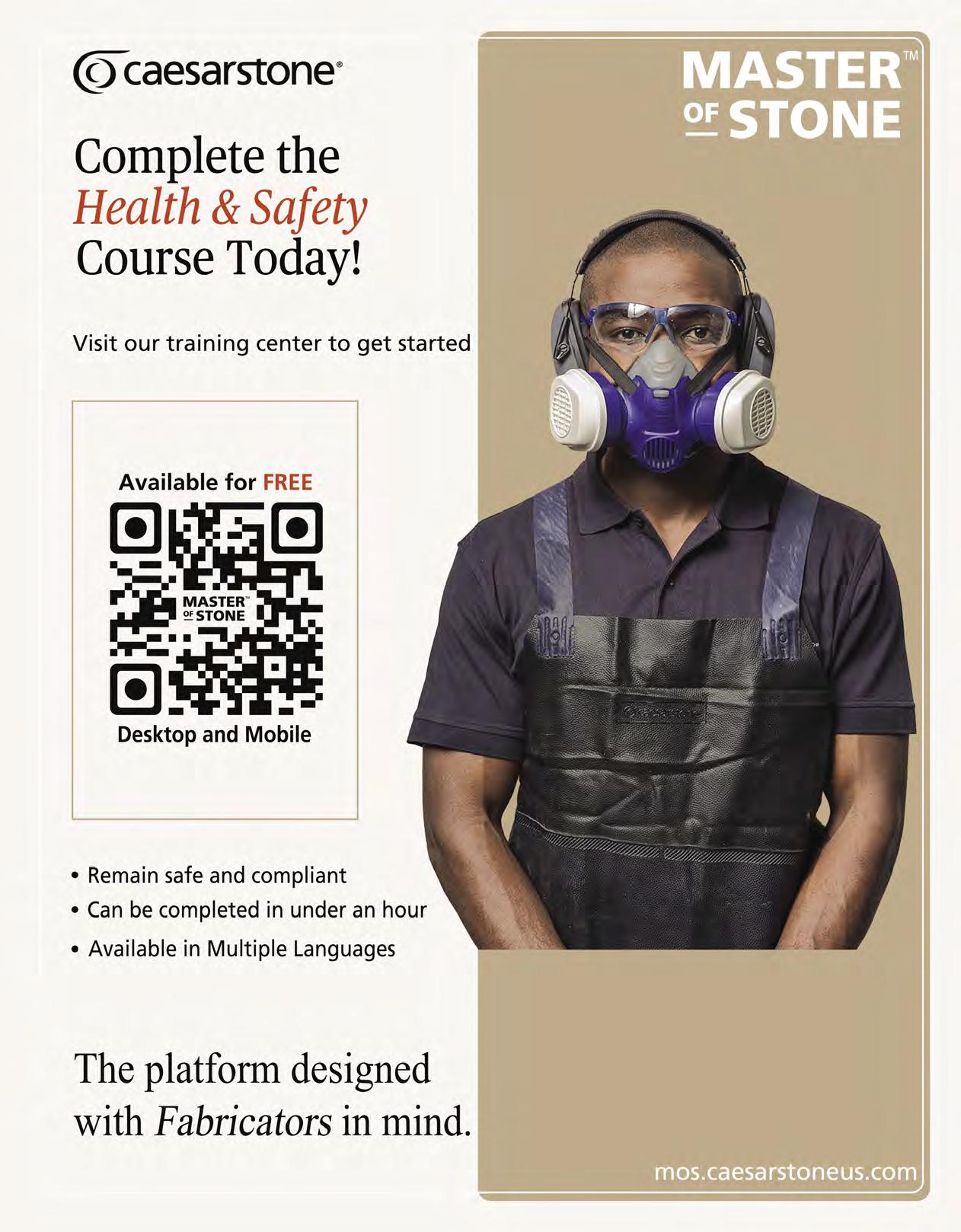
A recent report by Angi, a comprehensive solution for improving and maintaining homes, highlights a trend that stands in stark contrast to anxieties in many sectors: high job satisfaction in the skilled trades.
According to Angi’s data, 90% of tradespeople are satisfied with their careers. “Jobs across industries — from software development to media to research to education — could face job loss as a result of AI, but skilled home professionals are resting easy,” said Angie Hicks, co-founder of Angi. “The significant majority have no concerns about AI taking over their jobs; in fact, half of the pros we surveyed are excited to see how AI innovation can help them serve homeowners better.”
• Safe from AI: 65% of surveyed pros believe that their job in the trade labor market is safe from being threatened by AI while only 11% have concerns.
• Job satisfaction: 90% of tradespeople are satisfied with their choice of work, increasing from 83% since the pandemic. Labor shortage woes: Over 66% of pros agree that they would be able to grow their business if they could
Park Industries will hold its upcoming Digital Stoneworking Expo (DSE) on October 4, 2024, in Honolulu, Hawaii. This highly anticipated event will provide countertop fabricators with an unforgettable island experience filled with education, machine demos and exclusive tours of local fabrication shops.
For over 15 years, Park Industries has been hosting Digital Stoneworking Expos across the country, bringing together industry experts and fabricators to share knowledge, network, and experience live demonstrations of cutting-edge CNC machinery. The upcoming DSE in Honolulu promises to continue this tradition, offering valuable insights and educational sessions tailored to help fabricators grow their businesses and stay competitive in an evolving market.
Event Highlights include:
• Tour digital stone fabrication shops (Top Priority
find more quality skilled workers, and nearly 40% of pros said they could not find employees to fill open positions. In order to attract employees, pros said they were offering incentives like health insurance, above average wages and flexible work schedules.
• Younger generation outlook: Nearly 70% of tradespeople view the labor shortage as a problem vs. 77% since the pandemic. Workers aged 25-44 tend to be more optimistic about the future of the shortage, yet they are more likely to say younger people are not joining the trades due to stigmas surrounding trade roles.
• Solutions: Pros cited the top two reasons for scant entrants to these fields as a lack of exposure to trade careers paths in high school and historical stigma. Sixtyfive percent of pros said increased investment in high school trade preparation programs would help address this; 54% felt more should be invested in trade schools. The Report identifies a pressing challenge — a skilled labor shortage impacting the industry. To read the full Skilled Trades in America Report, visit www.research.angi.com/ research/__skilledtrades/.
and Todd Branson Stoneworks) and see the JAVELIN, SlabVision and more in action.
• Educational sessions with experienced fabricators.
• Interactive workshops on mitering, the digital process and more.
• Engaging roundtable Q&As.
“We are thrilled to bring the Digital Stoneworking Expo to Honolulu,” says Meagan Hegland, national sales director. “DSEs have always been about providing fabricators with the tools and knowledge they need to succeed, and we look forward to engaging with fabricators in such a vibrant setting.”
There is no charge to attend the Digital Stoneworking Expo, but space is limited and expected to fill up quickly. For the event agenda, the latest updates and to register, visit www.parkindustries.com/dse.

The ZOLLER Open House and Technology Days in June drew manufacturing professionals from across the United States, Canada and Mexico to the company’s headquarters in Ann Arbor, Michigan, to explore solutions to enhance efficiency.
This year’s event featured customer success stories, expert talks and demos of ZOLLER presetting, measuring, inspection, heat-shrinking, balancing, tooling, automation and tool management solutions.
The event also offered a preview of the ZOLLER booth for the International Manufacturing Technology Show (IMTS) to be held September 9-14 in Chicago. Open House attendees watched a sneak peek video of the »coraMeasure LG« automated tool measurement system that will make its North American debut at IMTS.
“ZOLLER’s nearly 80-year history of pioneering solutions that drive manufacturing excellence is rooted in our dedication to our customers,” said ZOLLER President Alexander Zoller. “Those who attended our Open House experienced first-hand our passion for supporting customers on their journey to greater efficiency. We look forward to continuing this journey at IMTS.”
To emphasize the “Integrate. Success.” theme of the Open House, customers shared powerful accounts of ZOLLER technology transforming their manufacturing processes. The event further underscored the importance of partnerships ZOLLER has cultivated to expand the application of its technology, as well as prepare young people for careers in manufacturing. A panel discussion with education partners from Washtenaw County, Michigan, highlighted ZOLLER apprenticeships, internships and other initiatives to train and mentor the next generation.
Cutting Edge Countertops, a premier countertop fabricator for the Midwest with five showrooms and three service centers across Ohio, Michigan and Indiana, recently announced the immediate acquisition of L.E. Smith Company, known as a leading laminate fabricator since 1950. The acquisition expands Cutting Edge Countertops’ ability to serve the commercial market through the fabrication and installation of hard surfaces, while also expanding the product offering with laminate and solid surface in multi-family commercial work.
“L.E. Smith appealed to Cutting Edge Countertops as part of our strategic growth plan, similar company values and deep roots in the commercial space,” said Brian Burns, Cutting Edge Countertops’ coowner and founding partner. “We are excited to welcome the L.E. Smith employees to the Cutting Edge Countertops family.”
“Cutting Edge Countertops is a perfect fit for L.E. Smith,“ commented Mari Ivan, L.E. Smith CEO. “Our current offerings of laminate and solid surface will be enhanced with hard surface materials including granite and quartz to further serve our
combined customers and their growing needs.”
Cutting Edge Countertops has experienced steady growth since opening its doors in 2006. The company expanded its service area through a strategic acquisition in 2016 to include locations in Noblesville and S. Indianapolis, Indiana, and Wixom, Michigan. This was followed by an additional acquisition in 2022 in Delaware, Ohio, to expand its footprint into the Columbus and Dayton markets.
Growth in the commercial space continues as young families are starting out and empty nesters downsize. Demand for multifamily housing has increased to 31% of all U.S. housing, according to the National Association of Home Builders. Multi-family homes are providing a more affordable housing option that often include communities with fitness centers, community pools and other amenities.
The acquisition adds 65 L.E. Smith employees to Cutting Edge Countertops’ workforce. L.E. Smith will continue to operate under its current name, as a subsidiary of Cutting Edge Countertops.
By Ed Young, Fabricator’s Business Coach
Sales management isn’t just about closing deals; it’s the backbone of any successful business operation. From setting targets to motivating your team, effective sales management is the key to driving revenue, fostering customer relationships and ensuring long-term growth. However, in today’s competitive landscape and uncertain economic climate, simply having a sales team isn’t enough. It’s crucial to master the art of sales management to maximize your team’s potential and propel your business forward.
Sales management encompasses a wide range of activities, from setting objectives and forecasting to motivating and empowering your sales team. It’s the engine that drives your business forward, fueling growth and profitability. A wellmanaged sales function generates revenue and builds strong customer relationships while enhancing brand loyalty and driving innovation. Effective sales management is essential for staying ahead of the competition and achieving sustainable success.
Many business owners struggle with managing their salespeople because they think salespeople are different or that making a sale is an isolated event. The truth is that salespeople aren’t any different than the rest of your employees. They need to know what is expected of them; they need goals; they need real-time feedback on performance; they want to do meaningful work; they want to be recognized and rewarded for their contributions to the company.
Making a sale is not an isolated event. It is the culmination of a process — a series of events. Just like a successful countertop installation depends on successful prior events,
getting the order depends on successful prior events. Sales management is about managing those events and the people who perform them effectively.
The sales process starts with lead generation. Typically, that includes social media ads, digital ads, email campaigns, traditional marketing and outside sales calls. Tracking metrics for each activity is essential.
Which social media and online ads generate the most clicks, form submissions and leads? What are the response rates to your email campaigns? How many sales calls are your outside salespeople making, and how many are successful? How is your lead acquisition cost trending? Tracking and trending these metrics will help you evaluate and improve your lead-generation process.
Follow-up is where most fabrication shops blow it. They will do many of the right things to generate new leads but fail to follow up on them.
To manage the follow-up process well, you need to define your process. What happens when you get a new lead? How quickly do you follow up? What is your follow-up process? How much of that process is automated (text, email) and personal (phone call, visit)? What is your follow-up sequence and timing (the order of texts, emails, and calls, and how far apart)? At what point do you consider the lead dead, and what happens to the lead then?
Tracking follow-up timing along with successful contact rates by salespeople is a great way to manage this phase of the sales process.
It’s obvious that you can’t get orders if you don’t generate quotes. How many quotes do each of your salespeople create each day? What is the average quote amount? What is the total quote volume each day, and is it enough to keep your shop well-fed? Breaking down this data by market segment, material type, quote amount, and salesperson will give you great insights into how well your process is working and where you need to improve. Note that follow-up is just as important after the quote as after receiving the initial lead. Tracking the same metrics here is critical.
Many shops have an idea of their average quote-to-order conversion rate. However, few actually track the data and trend it over time. Breaking this data down by salesperson, market segment, material type, and amount can give you valuable insights into which markets are the most lucrative for your business.
Setting clear expectations is crucial for aligning your team’s efforts and driving performance. Define your objectives, processes and performance metrics in detail. For example, when it comes to quote follow-ups, outline each interaction’s timing, communication methods and content. Documenting these expectations ensures clarity and accountability within your team.
Communication is key. Share the documented processes with your team, solicit feedback, and provide ongoing training and support. Effective follow-up involves regular feedback on performance and maintaining accountability. Solid tracking systems, such as Customer Relationship Management (CRM) software, are essential for monitoring performance and

ensuring accountability. Using a CRM is the key to managing data and keeping the emotions and assumptions out of the management process.
In addition to the follow-up activities that are part of the sales process, following up on the performance of individual salespeople is a must. You can set expectations, communicate and train process attributes and track data. Simply making individual performance data visible can help raise awareness and create some friendly competition. However, you must also check in with salespeople frequently, or you will lose the opportunity to improve their performance.
When an individual isn’t performing well, a lack of coaching support can create a “doom loop” of decreasing performance. Use the data to create teachable moments where the salesperson is motivated to improve. Structure your coaching time by understanding which part of the process the person struggles with. A little role-playing to practice the preferred behaviors can produce strong improvements in performance.
Effective sales management is a multifaceted endeavor that requires clear expectations, consistent follow-up and the use of technology to maximize efficiency. By setting clear goals, documenting expectations, and implementing structured follow-up processes, you can unlock the full potential of your sales team. In an uncertain economic climate, mastering the art of sales management is the key to sustaining growth and success. So, embrace the power of effective sales management and watch your business thrive in today’s competitive marketplace.
Ed Young is the owner of Fabricator’s Business Coach, a consulting firm designed to strengthen and elevate fabrication shops of all sizes. A former shop manager, Ed fully understands the challenges of today’s professionals. He has consulted with a range of businesses, from one-person startups to international Fortune 100 corporations, covering a broad array of products and processes. As a result, Ed knows that each business needs an appropriate structure for its unique situation. To learn more about how Fabricator’s Business Coach can take your shop to the next level, visit www.fabricatorscoach.com or reach Ed directly at Ed@fabricatorscoach.com.
By Mark Phelps, Synchronous Solutions
Many fabricators in the surfacing industry have had tremendous success using Synchronous Flow to improve their businesses from a production standpoint: reducing lead times, improving first-time quality and more. But can you apply Synchronous Flow to the marketing and sales side of your business? The answer is yes!
Synchronous Flow is the science of improving flow as it relates to information or material. Flow problems exist in all areas of your life. You experience these problems whether you are dealing with rush hour traffic, waiting in queue at your local DMV, or trying to pay your bills and needing a check to clear. The big challenge is trying to accomplish all you set out to get done with limited time and availability. Synchronous Flow brings an array of procedures, policies, tools and techniques to transform the business process from a chaotic, reactive, out-ofcontrol process into a disciplined, proactive and fully-in-control business system. If you’re familiar with Synchronous Flow as it applies to production, then you will see the same concepts applied to sales and marketing.
In sales and marketing, the focus is on the flow of information and people — customers. In this case, leads, prospects, and customers are your raw materials and the communication that occurs between them and your company representatives is the information.
When you run a marketing campaign, your goal is to generate leads. When a lead comes in, you want to ensure they are nurtured as quickly as possible. It’s essential to build a process and train your staff to be effective at it. Maybe you have someone who answers the call promptly, or you have an email inbox that gets monitored. The marketing process is about getting in front of people in your target market and engaging with them in a way that makes them want to do business with you.
Synchronous Flow is about designing the sales and marketing process that allows you to regulate the flow of leads and manage how effective the process is at achieving the company goals. The first step is to know the limits of the process. How many people can say, “Hey, I’m interested,” before the process breaks down? If one person says they’re interested, OK, no problem. If 100 people say they’re interested in a single day, could you handle all those leads with your current process and staff?
It’s crucial to understand: What is the limiting resource? How much is too much for our receptionist to handle? How much is too much for our sales team to handle? What is the constraint to processing new leads and producing quotes effectively? If you overload the production system, it will go into chaos; the same thing will happen if you overload a sales and marketing system.
How do you measure success? One way is to look at quotes. You can see how many leads are coming in, so you should be able to track those quotes and follow-ups. If you see a bottleneck, identify the constraint:
• What is the capacity of the team?
• What would enable the team to do more?
• What are some limits in the process?
With these insights, you can start to (re)define the process from that point forward. The goal is to improve your process continuously.
Your marketing system should get better and better. Every dollar spent on marketing should result in more quotes. Every team member in marketing should be able to handle more demand from the market.
An important thing to understand is what’s constraining your ability to respond appropriately to incoming calls. If someone inquires about a quote on a countertop project and you don’t respond to them in an hour or two, chances are they’ve already called someone else, and you may have lost that lead. You need
to be able to monitor your capacity and your incoming calls and make sure that you have sufficient capacity to answer the phone and respond in the timeframe that the customer expects — as soon as possible, on demand.
Outside sales is about getting new B2B relationships. One of the biggest constraints I see is that an employee is preoccupied with tasks that are not generating new relationships — the crux of their role. For example, I’ve seen outside salespeople responsible for assembling and delivering the samples and maintaining the sample racks. That is not developing new relationships. From a Synchronous Flow standpoint, what is your outside salesperson doing that’s not directly related to developing new relationships? Once you have identified those tasks, apply the process to figure out how to offload them to someone else so that your salesperson can focus solely on building relationships.
Another thing you don’t want your outside salesperson to do is create the paperwork associated with those relationships. Someone really good at talking with people is not always good at documenting the details in your CRM. So, you might need to consider offloading that work so they can focus on what they do well.
Whether they’re inside or outside sales, Synchronous Flow has a lot to offer in terms of how to focus and take your capacity


and your business to the next level. Equally important, or maybe even more important, is what Synchronous Flow has to say about pricing strategies.
Most businesses run off margins, but that thinking can get you in trouble. There is a perception that there is a certain margin a business needs to earn. Understanding what profitability really means and what relative profitability of jobs means is a game-changer.
Once you understand the relative profitability of jobs and what it takes to be profitable, you can empower your salespeople to go out there and buy new customers. How you do this is through aggressive pricing strategies in new markets. Once you’ve built the relationship, over time, you can gradually work the pricing structure up to your regular pricing. Leverage your capacity during a down market or slow times of the year.
One thing that I keep hearing from fabricators is that their constraints are moving from internal to the marketplace. Lots of you went out and hired people and bought new equipment during the pandemic boom, and you’re noticing it’s getting harder and harder to close deals. Yes, there is less demand in the marketplace than there was, but there is still way more demand than any of our clients can serve on their own. If you’re reading this article, you likely have not maxed out your marketplace. The market is still ample. Fabricators are still making money. There’s plenty of business out there. Success depends on how you innovate your processes to make room for opportunities for growth — no matter what the market is doing. C C C C A A A A
Mark Phelps is an owner of Synchronous Solutions, a firm dedicated to helping fabricators maximize their bottom line while on the continuous pursuit of excellence. Synchronous Solutions has helped over 100 fabricators build competitive advantages in their marketplace and grow to break new records, achieving financial control and life balance for their ownership and teams. To learn how Synchronous Solutions can help your business, visit www.synchronoussolutions.com. Have a new product or service announcement? ISFA can help you get the word out! Send press releases to Editor@ISFAnow.org or visit www.ISFAnow.org/advertise for more information about our marketing channels.
By Anthony Milia, owner of Milia Marketing
As a fabricator or surfacing industry professional, measuring the return on your marketing investments is critical to the success and growth of your business. The key lies in understanding the core customer journey — the interactions that lead a prospect to become a loyal, raving fan.
What steps are involved in turning a prospect into a customer? Where do they find out about your business? What actions do they take when they learn about you? What made them choose you? How was their experience after working with you? Would they come back? Would they refer family and friends?
Understanding these different touchpoints is critical in understanding your target audience and maximizing your marketing investments.
A customer journey is the series of interactions and experiences a customer has with your business over time, from initial awareness to becoming a repeat customer. The key elements of a customer journey typically include:
Awareness: How the customer first becomes aware of your products or services through advertising, referrals or online searches.
Consideration: The research and evaluation phase, where the customer gathers information to decide if your company’s offerings meet their needs.
Conversion: The point where the customer takes action, such as making a purchase, signing up for a service, or requesting a consultation.
Retention: The customer’s ongoing relationship and interactions with your business after the initial conversion, including repeat purchases, support and brand loyalty.
Advocacy: When satisfied customers become brand advocates,
recommending your company’s products or services to others.
Every customer who has purchased has gone through at least the first three stages of the customer journey. Many go through it in one day, and some might take a while, but if your business meets their needs, they’re likely to hit all those points on their journey.
A prospect might learn about your business through an advertisement, a social media post, or, most commonly, a recommendation. They might try to find out about your business by asking their friend, visiting your website or showroom, or requesting a quote. They’re trying to find out what services you provide, if your offerings are within their budget, what materials you sell and more.
If they’re satisfied with what they find, they’ll pay for the product or service and can either move on from there, return for more, or refer a friend.
It’s actually a simple process, so why isn’t every shop locking down customers and closing new deals? The answers are simple: competition and a poor understanding of customer behavior — the customer journey.
At every stage of the customer journey — awareness, consideration, conversion, retention and advocacy — different businesses take different actions and achieve different results.
Let’s compare two countertop shops in the awareness stage of the customer journey.
• Has a referral program that incentivizes previous customers whenever they bring a new customer.
• Employs data-driven, programmatic ad campaigns.
• Deploys engaging social media content that showcases their work and brand personality.
• Has strategic partnerships with local home design influencers and bloggers.
• Leverages search engine optimization (SEO) strategy to rank highly for relevant keyword searches.
• Has a presence at local home shows, trade events and community gatherings.
• Has attention-grabbing outdoor/billboard advertising in high-traffic areas.
• Optimizes their Google My Business listing and other local directory profiles.
• Has a billboard advertisement about the business.
• Has an unoptimized website.
• Has an inactive social media account.
Considering the positions of these two businesses, potential customers are more likely to discover Company A than Company B because Company A is taking a more comprehensive and strategic approach to building awareness.
But does that solve the problem of maximizing your marketing dollars? Well, not quite. That’s because the awareness stage is only one out of five in the customer journey. What about the other stages? Are you making it easy for customers to find, reach and buy from you? What exactly is working and what isn’t?
The comparison above shows that Company A has a more comprehensive approach to building awareness than Company B. However, not all of those methods would bring the desired results.
Tracking the customer journey begins with breaking down the customer journey into several touchpoints within each stage and analyzing the results each touchpoint delivers.
For example, Company A uses eight strategies to help prospective customers discover their business. However, they might realize after a thorough analysis that:
• Their website, through a robust SEO strategy, is where 30% of their leads originate.
• Their referral program helps them capture 25% of leads.
• Social media brings in 25% of new awareness.
• Their programmatic ad campaigns drive 20% of leads.
By closely monitoring the performance of each awarenessbuilding tactic, the company can understand which strategies are most effective at attracting new customers. This allows them to double down on the highest-performing channels, fine-tune underperforming tactics, and make more informed decisions about where to allocate their marketing resources
Similarly, the company would want to analyze the effectiveness of strategies at the consideration, conversion, retention and advocacy stages. Some key metrics they may track could include:
• Website engagement and conversion rates.
• Lead generation from product visualization tools.
• Customer questions answered by the sales team.
• Customer satisfaction and loyalty program participation.
• Repeat purchase rates.
• Average customer lifetime value.
• Online booking/ purchase completion rates.
• Revenue generated from sales calls.
• Upsell/cross-sell percentages.
Advocacy Stage:
• Online review sentiment and volume.
• Referral program conversion rates.
• Customer testimonials featured on the website.
By deeply understanding the customer journey and the unique impact of each strategy, you can continually optimize your approach to drive maximum awareness, consideration, conversion, retention and advocacy. This data-driven, customer-centric mindset gives you a significant competitive edge.
Tracking your customer journey involves monitoring and analyzing the various stages a customer goes through, from initial awareness to post-purchase behavior. Here are some key steps to effectively track the customer journey:
• Identify Touchpoints: Map out all potential touchpoints where customers interact with your brand, including online
ads, social media, website visits, email campaigns, customer service interactions and in-store visits.
• Set Up Analytics Tools: Use tools like Google Analytics, systems like ActionFlow, StoneApp, Measure Square, and specialized customer journey mapping tools like HubSpot to collect and analyze data at each touchpoint.
• Track Customer Interactions: Implement tracking codes or customized links in digital marketing efforts to see where customers are coming from and what actions they take on your website. Use heatmaps and session recordings to understand user behavior on your site.
• Analyze Purchase Paths: Examine the paths customers take from initial contact to purchase. Look for common patterns and drop-off points using funnel analysis. Tools like Google Analytics Behavior Flow or Conversion Paths can help visualize this data.
• Gather Feedback: Collect qualitative data through surveys, feedback forms and direct customer interviews. This helps to understand the motivations and pain points behind customer actions.
• Use A/B Testing: Conduct A/B tests on different touchpoints (like website landing pages, email subject lines or ad creatives) to determine which variations lead to better customer engagement and conversion rates.
• Monitor Social Media: Track social media interactions and mentions using tools like Hootsuite, Sprout Social or Brandwatch to understand customer sentiments and engagement.
• Integrate Data Sources: Combine data from various sources (website analytics, CRM, social media, customer service) into a single platform for a holistic view of the customer journey. Data integration platforms like Segment or Zapier can facilitate this process.
• Segment Your Customers: Segment customers based on demographics, behavior and purchase history. This helps in understanding different customer journeys and tailoring marketing strategies accordingly.
• Visualize the Journey: Create visual maps of the customer journey using tools like Smaply, Lucidchart or Microsoft Visio. These maps can help identify key touchpoints, pain points and opportunities for improvement.
• Evaluate and Adjust: Regularly review the data and insights gathered to evaluate the effectiveness of your customer journey strategies. Adjust as needed to improve the customer experience and drive conversions.
Harnessing the insights of digital marketing barriers and create a more simplified tracking approach that lets you track your different touchpoints at the various stages of the customer journey. Here are some ways to track effectiveness from first brand engagement through project completion:
• Track website traffic sources, bounce rates and time on site.
• Monitor social media engagement (likes, shares, comments).
• Measure the effectiveness of advertising campaigns (impressions, clicks).
• Survey customers on brand recall and perception.
• Analyze form submissions, live chat inquiries and phone call volume.
• Track lead sources (organic search, referrals, ads, etc.) and lead quality.
• Monitor lead response time and sales team productivity.
• Implement lead scoring to prioritize high-potential prospects.
• Record appointment scheduling rates and customer no-show percentages.
• Evaluate consultation close rates and average deal size.
• Gather customer feedback on the appointment and consultation experience.
• Identify any friction points in the scheduling or consultation process.
• Track proposal acceptance rates and reasons for lost opportunities.
• Measure project timelines, on-time delivery and customer satisfaction.
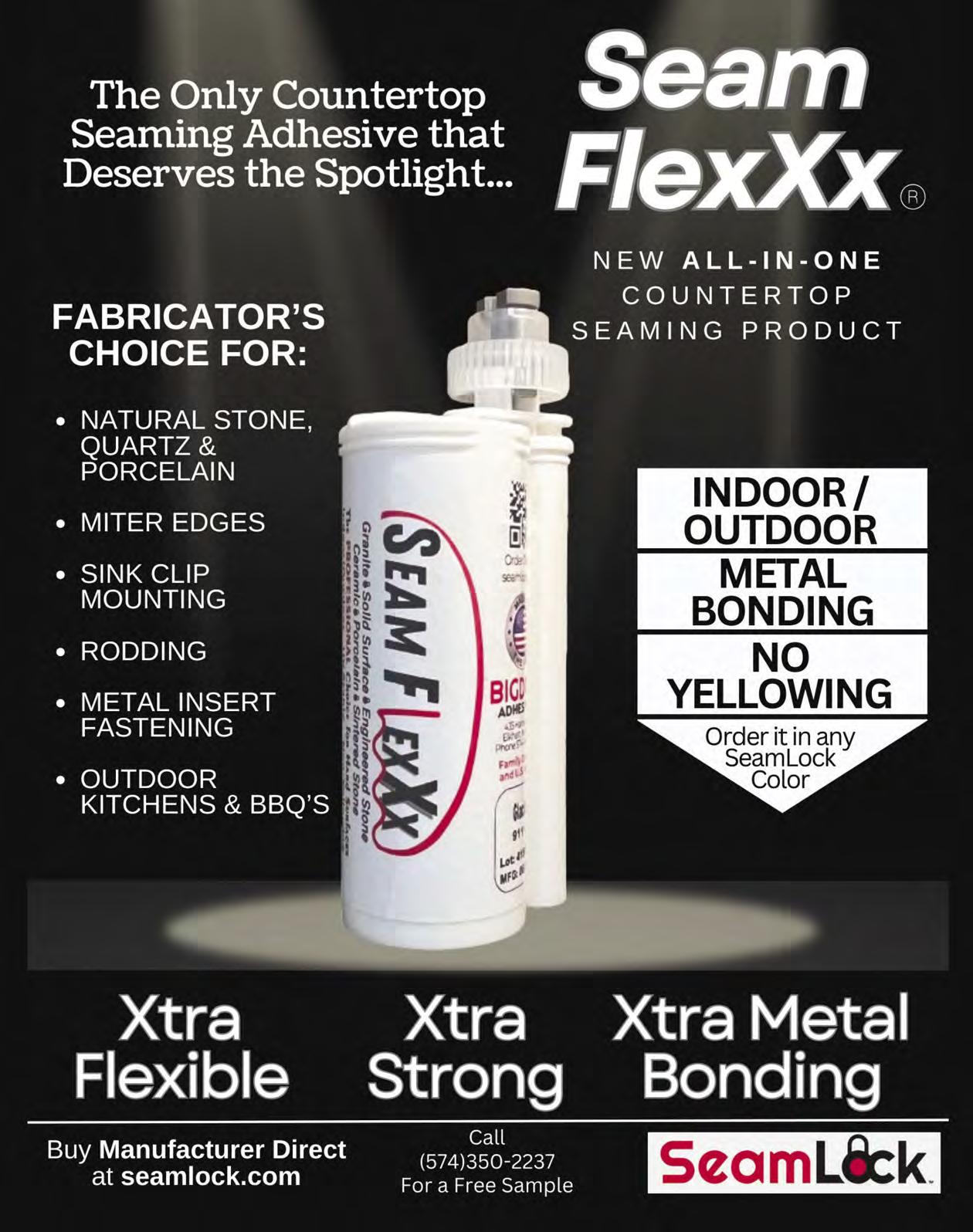
• Monitor post-project referrals, online reviews and repeat business.
• Analyze project profitability and identify opportunities to improve margins.
Ongoing Customer Relationship:
• Evaluate customer retention rates and churn.
• Analyze customer lifetime value and upsell/cross-sell effectiveness.
• Gather feedback through surveys, reviews and customer interviews.
• Identify ways to strengthen loyalty and advocacy.
By closely monitoring these touchpoints across the customer journey, you can uncover valuable insights to optimize your marketing, sales and service strategies. This data-driven approach allows them to deliver a seamless, high-quality experience that maximizes customer acquisition, retention and advocacy.
You’ve spent thousands or even hundreds of thousands of dollars this year marketing your business, aiming to reach qualified leads, retarget warm leads and previous customers, and maintain your referral program. Now what?
To optimize your core customer journey, you must first understand which marketing efforts yield results and how much. This understanding will enable you to decide which strategies to keep (if it’s great), discard (if it’s not working), or improve upon (if it has potential).
This leads to the question: How do you calculate your marketing return on investment?
Let’s assume your business ran a one-month digital advertising campaign with the following costs and performance:
Campaign Costs:
• Ad Spend: $20,000
• Ad Management Fees: $3,000
• Total Campaign Costs (Ad Spend + Ad Management Fees): $23,000
Campaign Performance:
• Website Visits: 25,000
• Leads Generated: 52
• Consultations Booked (Qualified Leads): 38
• Projects Sold: 27
• Average Project Value: $5,000
Now, calculate the customer acquisition cost (CAC), or the total expense incurred to acquire a new customer, by dividing the total marketing and sales costs (total campaign cost) by the number of new customers.
$23,000 / 27 = $851.85.
This means that you spent $851.85 to make a $5,000 sale. Now, calculate the revenue generated from the campaign.
(Projects Sold × Average Project Value = Total Revenue)
27 × $5,000 = $135,000
(Total Revenue / Total Campaign Costs = ROI)
$135,000 / $23,000 = 5.87
This means that for every dollar spent on the digital advertising campaign, the business generated $5.87 in revenue.
(Total Revenue – Total Campaign Costs / Total Campaign Costs x 100)
$135,000 - $23,000 = $112,000
$112,000 / $23,000 x 100 = 487%

There are plenty of how-to marketing guides out there, but this one focuses on tried-and-true methods that are essential for every business. No, it won’t walk you through how to set up a social media page, but it will offer you the advice you can implement today to see results like more customers and better performance in your marketing.
The impact of effective marketing is staggering, but incredibly hard to get right. Only by learning from the successes and failures of businesses in recent history can we see a clear path to harnessing marketing’s true power. Reacting to the ever-changing environment around you and using it to your advantage is the best possible strategy.
Marketing Magnifier examines what crucial elements are required to propel your business by examining what has worked and failed for many modern organizations in real-life situations and how to apply them.
This is not just another marketing book … it is the key to growth above and beyond your expectations.
Filled with invaluable knowledge, advice and strategies, this book is a mustread for every business professional looking to climb to the top, carve out a market and bring in more business. Get your copy at www.miliamarketing.com/purchase-marketing-magnifier-book/.
In this example, the return on investment using digital advertising was high, indicating a highly effective and profitable campaign.
Understanding this ROI is crucial for comprehending the customer journey, as it highlights the stages where marketing efforts are most effective. You can identify critical moments in the customer journey that drive engagement and sales by analyzing which touchpoints and interactions lead to high conversions and revenue. This insight allows for more strategic allocation of marketing resources, targeted improvements in customer experience, and refined messaging to enhance customer acquisition and retention.

The most successful businesses take a comprehensive, datadriven approach, diversifying their tactics to maximize visibility and lead generation while strengthening long-term customer relationships and advocacy. This holistic view of the customer journey is a critical competitive advantage in today’s crowded marketplace.
Ultimately, the ability to deeply understand and continually enhance the customer experience separates industry leaders from their competitors. Companies that prioritize this customer-centric mindset will be well-positioned to attract, delight and retain their ideal customers.
C C C C A A A A B B B B 2 2 2 D V V V V
Anthony Milia owns Milia Marketing, an award-winning digital marketing agency specializing in solutions for kitchen and bath dealers and fabrication companies. They help clients build brand awareness, improve lead generation, boost sales, increase audience engagement and enhance customer retention. Anthony’s approach has consistently raised the digital marketing standard, helping companies distinguish themselves in this competitive market. He is also the acclaimed bestselling author of Marketing Magnifier, an actionable guide to effective marketing strategies. Schedule a consultation by visiting www.miliamarketing.com/discovery.

By Tim Saddoris, president of Grand Onyx

Many surface fabricators think it’s too complex or they don’t have the technical chops to harness artificial intelligence, but that’s not true. In a lot of ways, AI is easier than using Google — and even replacing Google in many cases. So, let’s dig into AI and why it’s essential to understand what it can do in our industry.
So, let’s look at the four levels of AI and how you can put it to work for your business.
Level 1: Ask a question. ChatGPT works by responding to user-generated prompts. Prompts are questions that you ask to get answers. Here are some examples of how this plays out.
Writing Friendly Past Due Notices: Let’s say you have a customer that is 90 days past due. Ask ChatGPT to write a fivesentence email with empathy, mentioning that you are a surface fabricator business and that they are one of your top customers. It drafts the email in seconds.
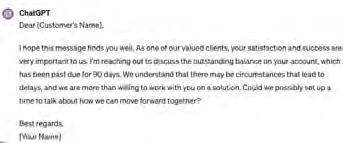
Creating Photos for Your Website or Sales Brochure: AI can generate photos. I had a customer who wanted to do inhome consultations for retail sales but didn’t have any photos for their website. So, we had AI generate them for us. The examples below are all AI-generated and immediately improved the professional look on their website as they launched a new service line.

Level 2: Provide Data. AI can also help you sort data and find the key insights you need to make better decisions.
Product Comparison: Maybe you are trying to decide between two different machines. You’re not an automation expert, and they look very similar. So, ask AI.

In seconds, you get the information to compare more easily. The paid version of ChatGPT can go out to websites, pull information, and put together a chart like this:
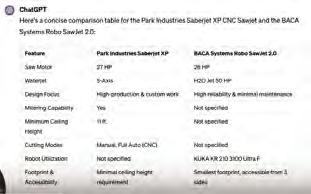
While this may not be enough information to decide on a significant investment like this, it can give you a quick overview. If you had a PDF of detailed specs, you could upload it and ask AI to go into greater detail. It’s an independent business consultant that can provide basic advice.
You might also ask about the key things you should consider in making such a purchase and get a list of things you should think about. While the list might not be all-inclusive, it can help make sure you’re not missing something important.
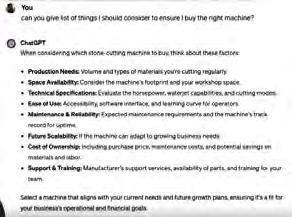
Contract Review: Contracts are often laden with lots of
legalese. Want a quick overview? Upload the contract and type in your prompt. ChatGPT will quickly scan all pages and provide you with a list to review, in order of importance.

While it’s not going to replace your careful consideration or your legal adviser, we’re only in version 4 of ChatGPT. Future iterations will only get better. For now, think of it as a tool to help you focus on the big things.
Other ways you can use AI to help guide your business decisions include balance sheet analysis, customer sales trends, dent analysis, and material and inventory trends. Like the contract example, you can upload the data and ask questions to pull out insights or trends you might spend a lot of time parsing yourself or overlook entirely.
Level 3: Create an Avatar. Using AI, you can create an avatar that acts a certain way. For example, almost nobody in the fabrication business has a human resources manager. However, you still have to deal with human resources obligations.
Job Descriptions: Let’s say you need to write a job description. You can train ChatGPT with a sentence like, “You are an HR manager for a surface fabricator.” Provide your website address, and it will learn about your business. Then, you can guide the AI engine in creating your job description. Now, when you ask AI to create a job description for an installer for your business, you might get a result like this:

You can refine the output to get as detailed as you want. Perhaps you want this to be more specific to your company and how you do business. You’re competing with every other
business looking to hire skilled labor, so you need to do a little more selling of what you have to offer to grab someone’s attention. You might prompt ChatGPT with something like this:

Notice what we’re doing here. We are asking ChatGPT what information it needs to improve the quality of its output. In response, you’ll get questions you can answer to help hone the job description.
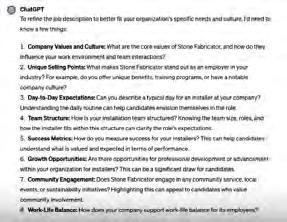
Aswering these questions will create a more customized output that fits your business and gets people excited about joining up.
Sales Training Sessions: Maybe you want to hold sales training for your team. By defining your avatar as vice president of sales, you can ask ChatGPT for a training itinerary. One of our clients did so and created a structured sales training strategy for a Saturday session. With prompting, It then helped break down the sessions, such as classifying customers when they walk in your door, upselling, closing techniques and more.
Level 4: Process Automation. This is where you bring everything together. For example, I use an AI notetaker in all my meetings. It records the meeting.

At the top of the screen on the left, it even suggested next steps, ideas and open questions that need answering. About 10 minutes after the meeting concluded, it was delivered to my mailbox, letting me search and find key points quickly. Another example is shop floor efficiency. In this image, cameras are monitoring baristas in a coffee shop. On the right side (blue), it’s tracking how many cups each barista produces. On the left (green), it tracks how long each customer has been in the shop.
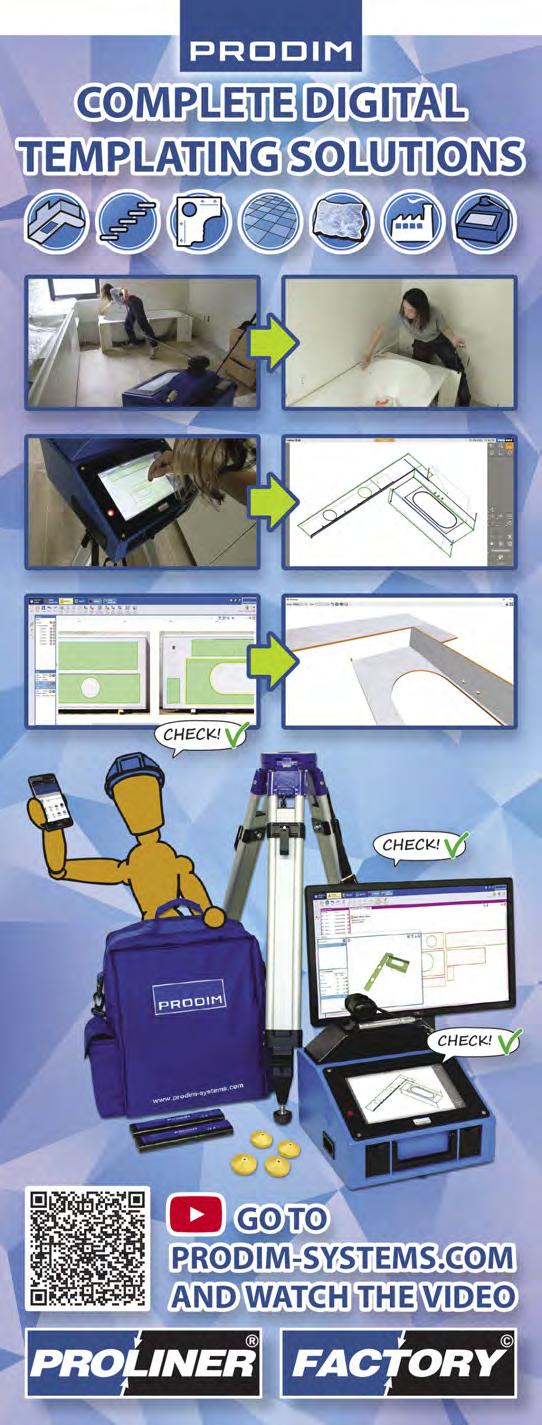

Think about how this could apply to your fabrication business. Maybe it analyzes fabricator and forklift routes on the shop floor or tracks the amount of manual labor a job takes to ensure you get the margins you need.
How often have you overheard a conversation like this? A customer calls with a question like, “What time do you close?” The salesperson answering the phone says, “We close at 5,” and ends the call. That is not what you want to happen. They missed an opportunity to engage with a customer, get an idea of their project and set an appointment.
We can record and take the transcriptions of all the phone calls and ask AI to analyze all calls. By uploading the data (Level 2), AI can provide the data on what’s being discussed and whether your reps are following up with questions and setting appointments.
We then apply Level 3, which is creating an avatar. In this case, we might find a well-known sales expert you trust and ask ChatGPT to analyze the data in their style. You can get a scorecard along with recommendations. Bringing it all together in Level 4, you can create a way to improve performance. For every incoming call, you can score calls based on the key questions your AI avatar expert says you need to ask.

Now, let’s score a new call based on these questions. Here’s a typical conversation between a potential customer and Greg, your sales rep:
Agent: Good morning. This is Greg. How can I help you?
Caller: Yes, I was wondering what your price ranges are for granite countertops.
Agent: I would say they probably start at about $100 per square foot, templated and installed, and certainly go up from there.
Caller: Got it. And do you offer financing?
Agent: We do not.
Caller: OK, thank you. Bye.
In this quick conversation — based on the things you want your salesperson to do here — you can score performance on each question and see that they clearly failed.
By doing this on each call, you can help Greg develop the right habits, providing concrete feedback about whether they are following your sales process and drawing customers into the sales funnel.
AI isn’t going to replace Greg. You need that authenticity and human connection, but AI can work as a teaching agent to help improve your sales process.
But wait! There’s more! In this constantly evolving landscape, new developments are unfolding. Here are some AI opportunities that we think can have a big impact on this business:
• Improving your closing rates: analyzing thousands of calls
to find top performers and uncover what they do to generate sales.
• Saw scheduling: pulling data out of your system and helping automate scheduling.
• Inventory predictions: better demand forecasting and inventory reorder points.
• Shortening installs: how you manage client scheduling and reminders.
• Shop floor and efficiencies: optimizing your workflow and improving your margins.
The bottom line: You cannot afford to be left behind when it comes to AI. Many of you in the fabrication business were around before computers or smartphones with cameras, and now those are cornerstones to everyone’s success. AI is the next tool that can help you in ways you never imagined.

Tim Saddoris is the president of Grand Onyx. a firm dedicated to helping stone fabricators increase their revenue by 30% to 300% using proven techniques and a World Class Blueprint System to help you build a more profitable, scalable business. They help companies refine their sales process, uncover insights about better ways to sell, and coach sales teams for greater success. Learn how Grand Onyx can help your business grow at www.grandonyx.pro.


By Sarah Peiper
The surface fabrication industry relies on software and technology solutions to enhance efficiency, precision and creativity. Here are a dozen of the most popular solutions used in this industry, designed to streamline processes, monitor material inventory, track jobs, review metrics and provide a richer experience for your customers — all of which lead to better margins and more sales.
ActionFlow’s intuitive countertop fabrication software simplifies operations through automated task management, end-to-end tracking, and centralized, cloud-based data storage. The advanced insights you gain with our solutions empower you to make better decisions for your business and minimize chaos and disorganization.
Key functionalities include customer relationship management and project management, allowing users to create, assign, and monitor tasks and milestones throughout the fabrication process. Inventory management is another crucial feature, enabling users to keep track of materials, supplies and equipment, ensuring that resources are available when needed.

ActionFlow also excels in production scheduling, providing tools to plan and organize production workflows, assign jobs to specific machines or workstations, and track progress in real time. Its integration capabilities allow seamless communication with other software systems, such as accounting and CAD, ensuring a cohesive workflow. Learn more at www.actionflow.net.
In stone fabrication, accuracy is nonnegotiable.
Flexijet Stone software offers easy and precise measurements, from wall cladding to countertops. Measuring digitally with Flexijet cuts out guesswork, capturing exact scribes even on uneven surfaces. The built-in camera ensures clarity for design and installation.
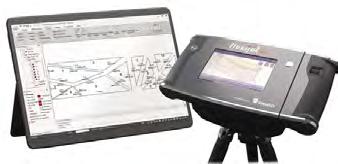

The new and improved “Find angles between pieces” feature enables operators to easily find angles between complex surfaces and stamp them onto drawings.
Complex projects with multiple planes interacting were challenging in the past. With Flexijet 3D, measure surfaces in 2D and visualize them coming together in 3D to understand how the pieces meet. Flexijet 3D allows operators to measure complex projects efficiently and accurately with multiple angles for cut and assembly.
Flexijet Stone reduces trips, minimizes risk and boosts profitability. For more information, visit www.myflexijet.com/stone.
FreePower provides an approach to powering devices, eliminating the limitations of traditional charging pads. This proprietary technology allows for true position-free charging, enabling multiple devices to charge simultaneously anywhere on the surface. It supports a wide range of devices, from smartphones to wearables, making it versatile for personal and professional use.
Physical spaces are always built with longevity in mind, so future-proofing embedded technologies is crucial. FreePower’s firmware is upgradeable over the air, allowing it to adapt to evolving needs and advancements. It provides peace of mind that this solution will stand the test of time and deliver longterm value to clients. Visit www.freepower.io to discover how you can embed this technology into your next project.
Job Well Done is a comprehensive software solution designed to enhance communication and streamline operations fabrication workflows. It significantly improves communication between field crews and office staff, ensuring information flows smoothly and efficiently. Integrating with Moraware Systemize, Job Well Done reduces reliance on paper, facilitating a more organized and ecofriendly workflow.
Key features include Job Well Done Field and Job Well Done Dox, which provide easy access to job information. Users can log in from any mobile device to view all relevant job details. Job Well Done Ping automates communication through companybranded texts and emails for appointment reminders and post-job follow-ups. For more information, visit www.jobwelldone.com.

LT3Raptor is a new digital templating platform designed with a robust cloud-based management hub to make you faster and more efficient in templating and other areas of your process, including job management, programming and more.
This new platform encompasses myriad functions and tools subscribers can access, including LT3Raptor, LPI Cloud, StoneTag label system and LPI Learning Management System. This evolution is designed to revolutionize LPI’s customer experience, bringing continuous innovation, efficiency and seamless collaboration now and in the future to help grow and sustain their businesses. If you are interested in learning more about LT3Raptor, visit www.lt3raptor.com
Moraware’s tools help countertop fabricators easily create quotes confidently and keep everyone (at the office and in the field) on the same page about every job in the schedule.
With CounterGo, simple drag-and-draw features are used to build precise countertop drawings and calculate costs immediately. Create, print, and show professional quotes on the spot, and easily adjust quotes if needed. Moraware also integrates with QuickBooks.
Systemize is an all-in-one-place job scheduling, viewing and management tool. With Systemize, you’ll see every job — and its status — in one master list. See what’s happening, when and where with color-coded calendars for templates, fabrications and installations. See where your crews are working (and where they’re working next) so you can assign jobs more efficiently.

Moraware’s tools are web apps, so there’s nothing to install. You can use a desktop, laptop, tablet or even your phone. Moraware works on a month-to-month contract with no hidden fees or setup costs, and the company offers unlimited support. Learn more at moraware.com.

PHOTOTOP 5 from Fabricator’s Choice just keeps getting better with added capabilities. Functionalities include the ability to auto-create miter strips, autocreate lamination, auto-dimension on PDF output and more. PHOTOTOP 5 makes templating fast and accurate, making the program easy to use. Professional training and online support are available. Integrate templating with office inventory, job management systems and shop equipment. Multiple software licenses are not required to expand PHOTOTOP 5 to additional templaters. Simply order ORGANIZE Field Kits, which include a laptop, camera and markers. The exclusive Organize On-site Tool provides immediate confirmation and file delivery of the most highly detailed digital templates in the business. For more information, visit www.fabchoice.com.
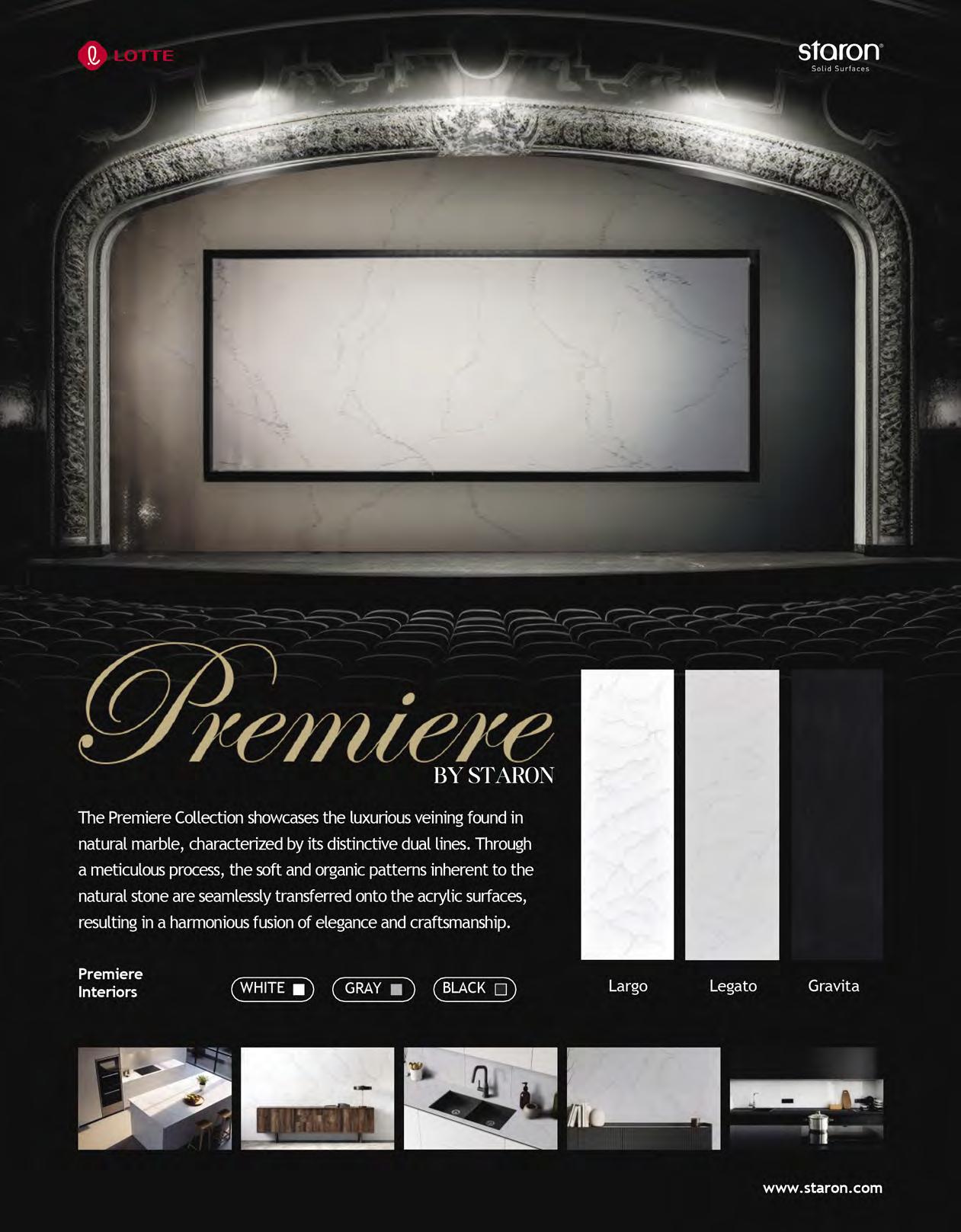
Prodim Factory Software connects field, office and production teams. With four available versions of the software with increasing levels of functionality, businesses can choose the software that best matches their requirements. For instance, the innovative Factory Draw Advanced provides an easy as-is multiple-plane design with insightful 2D and 3D views and solid collision alerts. By entering details like the material type, thickness and glue offset, Factory Draw Advanced can be used to make calculations, identify potential problems and make design decisions. With Factory Full Fabricator, you can even build your digital slab library and match all your slabs in your designs. Prodim’s Factory Fabricator is the complete solution for exactly what it says: Fabrication! For more information and demonstration videos, visit www.prodim-systems.com.

The Basic Bundle of the Slabsmith System includes all essential features and modules necessary for efficient countertop fabrication management. Key functionalities encompass inventory, layout, digital slab creation and more, ensuring a streamlined workflow from start to finish.

Slab Maker is a core component that creates accurate digital slab inventories. It ensures dimensional accuracy and color consistency, minimizing the need for remakes. Slab Maker’s digital inventory facilitates live website updates and allows users to search slabs by size, view stock levels, see committed slabs, and customize queries for sales, manufacturing or accounting purposes. The system can automatically calculate slab values and adjust them when slabs become remnants, providing detailed inventory insights. Perfect Match is the layout software that simplifies arranging slabs. It allows effortless clicking and dragging to position counters and shapes for optimal yield. Job Manager organizes and provides information on all Slabsmith jobs, offering a complete history of processed jobs. Users can find slabs committed to a job, view customer information, change layout statuses and get yield statistics.
To learn how you can decrease operating costs while increasing yield using Slabsmith, visit www.slabsmith.com.
Park Industries has partnered with Taglio Software House to introduce SlabVision, a cuttingedge slab scanning system. This advanced technology enables fabricators to digitize slabs with remarkable detail, using a high-resolution industrial linear camera and an LED lighting system to capture each slab’s true colors and attributes, including thickness, quality and measurements.

SlabVision’s compact design maximizes workspace efficiency, accommodating the needs of modern stone fabrication facilities. Its advanced LED lighting system guarantees consistent image quality by eliminating the impact of environmental conditions like sunlight or shop lighting. The intuitive 24-inch touchscreen interface ensures effortless operation, allowing fabricators to achieve precise results quickly and efficiently. For more information, visit www.parkindustries.com/slabvision.

SlabWare is a software specialized in inventory and sales management for surface fabricator businesses. The solution is designed to transform companies by automating processes, improving organization, and making workflows much more agile and productive.
The company’s goal is to help fabricators minimize pain points. With SlabWise, you can precisely determine slab quantity and seam placement, create professional quotes and invoice customers. Job Tracker helps organize and connect the whole team in a simple and fast way to optimize the fabrication process up to countertop delivery. Users can create and edit packing lists, invoices and more. All features are linked with inventory, so your offerings update automatically online, and all information is accessible from any device. Get a free trial at www.slabware.
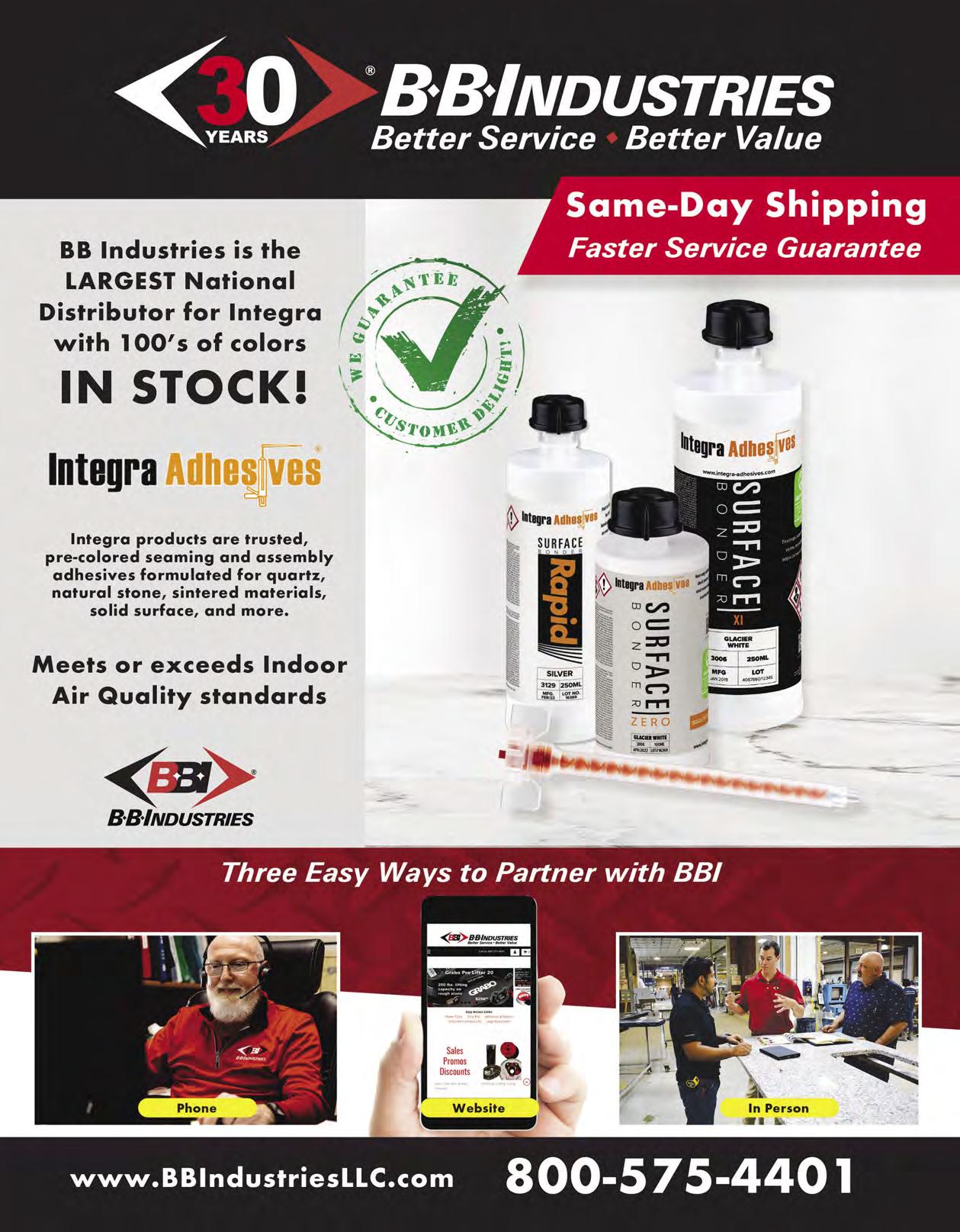

StoneApp by StoneGrid is a comprehensive software solution designed to streamline. The app offers multiple modules to enhance efficiency and productivity, covering inventory management, quote management, project management, purchase management and more.
The inventory management feature allows businesses to conduct quick and accurate inventory counts; it integrates with your website, providing real-time inventory to customers and staff alike. For quoting, StoneApp facilitates efficient lead management and conversion. It includes features like web-to-lead forms, follow-up scheduling and the ability to convert leads into quotes seamlessly. The app also allows for detailed countertop drawing and layout. Additionally, StoneApp supports purchase management by generating purchase orders, receiving inventory, and synchronizing with the inventory module to ensure accurate tracking of materials and supplies. This robust solution integrates with QuickBooks, Slabsmith and many other popular tools used by fabricators. Schedule a demo at www.stonegridusa.com.

Explore how software can be as game-changing as new machinery in episode 33 of ISFA’s Behind the Surface podcast. Hear from StoneAPP’s Mickey Gault, a 20-year fabrication veteran, on how to unlock the power of tech and get a roadmap to success.
If you’re considering implementing software or looking for technology that helps you streamline your workflow, this episode is for you. Listen in at www.isfanow.org/podcast-behind-the-surface.

By Louise Scott, Integra Adhesives

When it comes to countertops, selecting the right adhesive and sealant for each application is crucial to ensuring a durable, long-lasting, aesthetically pleasing finish. Adhesives play a vital role in bonding materials where mechanical fasteners fall short. Each countertop application and substrate have unique properties, necessitating a range of adhesives to achieve the best results. By understanding the different adhesives and sealants available, fabricators and installers can make informed choices on which products to use and when.
For undermount sink installations, there are two primary options: a purely mechanical fastening system or a combined mechanical/adhesive fastening system.
Mechanical fasteners use a physical attachment to hold the sink in place. Examples of this type of attachment method include drilling into the underside of the countertop to insert bolts/clips or attaching clips and straps to the wooden cabinetry. Using this method increases installation time and includes the risk of damage to the countertop.
Alternatively, using an adhesive like Component Bonder from Integra Adhesives allows undermount clips to be installed in advance so that onsite, the installer can fasten the clip bolts and fix the sink in place in just a few minutes. The position of the sink can then be easily adjusted, making it easy to apply silicone or MS Polymer to create a watertight seal before tightening it into place. Look for an adhesive with high impact resistance, as sinks are subject to dynamic loads.
Fixing the surface to the cabinet involves bonding two dissimilar materials: the countertop material (solid surface,
quartz or natural stone, for example) and wood (plywood or MDF). The differences in materials bear consideration due to different expansion and contraction rates, moisture absorption, flexion and impact resistance. In these situations, it is best to choose an adhesive with high elongation for flexibility. Fabricators typically consider three options:
• Hot melt glue: Hot melt is quick and easy to remove, making it ideal for templating, but it relies on a mechanical bond, which isn’t suitable for smooth surfaces.
• Silicone: Silicone offers excellent properties for substrate mounting but is slow to cure, with a typical fixture time of 24 hours.
• A specialized product: Substrate Bonder is a specialized product by Integra Adhesives that was developed specifically for this application. It cures in as little as 15 minutes, balances elongation, and has high lap shear strength and speed, making it ideal for this application.
Traditionally, silicone is used for attaching and sealing a backsplash, but unfortunately, it is slow to cure and lacks quick grab. An MS Polymer is a better alternative, offering quick grab and sealant properties in one. Available in a wide range of colors, MS Polymers provide a waterproof and color-matched seal, curing hard for easy cleaning and paintability. These durable products are also excellent for attaching shower panels and creating watertight seals in bathrooms.
Countertop rodding is a technique used to reinforce natural stone. Rodding involves cutting a channel in the stone, inserting
a stainless steel or fiberglass rod, and then encapsulating it. The material thickness, the cutouts and the stone strength determine whether rodding is required. There are a few options for rodding adhesives on the market, but not all are created equal. Essential characteristics are low shrinkage, thixotropic (self-setting) and quick curing for throughput. It’s important to keep in mind that solvent-based adhesives can shrink during the curing process as liquid evaporates. If the adhesive shrinks too much, the channel can pinch in on itself, cracking the stone. It’s also good to use an adhesive that can flow enough to fill the relatively small channel but also sets quickly so as not to make a mess. There are several adhesive options on the market. Three popular choices are:
• Epoxy: offers low shrinkage but has a prolonged curing time, creating bottlenecks in fabrication processes.
• Hand-Mix Adhesives: available options can be wasteful and messy. Incorrect activator-to-adhesive ratios can lead to quick curing, shrinkage and brittleness, reducing the strength of the bond. Thin adhesive consistency is required for application, often resulting in leftover waste and increased fumes during curing.
• Rodding Bonder: a cartridge-based adhesive that cures in less than 15 minutes with virtually no shrinkage. It can be directly injected into channels, minimizing waste and enabling rapid completion.
Color-matched adhesives are essential for creating a seamless look in countertops. Whether you’re pulling a deck seam, lamination or a miter, each type of surfacing material — solid surface, quartz, natural stone, porcelain, laminate and others — has its own adhesive requirements. Fast-curing, high-

strength Methyl methacrylate (MMA)-based adhesives are ideal for solid surface due to their UV stability, moisture resistance and low VOC content. A zero-sag penetrating adhesive is preferable for harder surfaces like quartz, stone or porcelain, especially for onsite seaming with limited space. When working on vertical or mitered angles, a zero-sag adhesive assists with bond strength and reduces mess and waste. For external applications, UV-stable polyurethane adhesives outperform MMA or epoxy in maintaining color and durability. Highvolume shops benefit from rapid-curing MMA-based adhesives to increase production efficiency.
Selecting the appropriate adhesive for each application is vital for achieving durable, high-quality results. Understanding the unique properties of various substrates and applications allows fabricators and installers to make informed choices, ensuring strong, long-lasting bonds and aesthetically pleasing finishes. From undermount sink installations to substrate mounting, backsplash bonding, reinforced rodding and seamless countertops, success depends on using the right adhesive.
Using adhesives over mechanical fixings helps avoid the risk of countertops cracking under dynamic loads, ensuring the longevity and stability of the installation. Additionally, the proper use of adhesives and sealants ensures watertight seals, crucial for preventing moisture damage and maintaining the integrity of kitchen and bathroom surfaces. By leveraging the knowledge and options available, professionals can enhance their craftsmanship, reduce installation time, and ultimately deliver superior results that meet the highest standards of quality and durability.



The principles of the circular economy have guided Finnish manufacturer Durat from the company’s inception. With a desire to use surplus industrial plastics as the raw material for high-end design products, the company is a leader in material innovation and sustainable practices.
By Sarah Peiper
Based in Finland, Durat was founded in 1990. The company’s main product, solid surface sheet material, is the result of its founders’ aim to reuse plastic waste as high-quality surfacing for design applications. The primary objective was to reduce the amount of plastic ending up in landfills. With intelligent innovation and design, Durat repurposes plastic waste to create a complete line of solid surface products while reducing negative environmental impacts.
A genuinely sustainable material, solid surface can have a long lifespan due to its exceptional repairability and durability. Durat takes it further: To ensure material circulation, the company buys back all remnants from fabricators and recycles any retired installations like furniture or casework. Remnants generated during Durat’s production process are also fully recycled.
Durat solid surface contains 30% recycled industrial plastic waste and is 100% recyclable. In 2022, the company repurposed nearly 126,000 pounds of industrial plastic waste, the equivalent of the weight of approximately 10 million plastic bottles.
Durat received its first Environmental Product Declaration (EPD) in 2023, a certification that transparently communicates the environmental performance or impact of any product or material over its lifetime. According to the EPD, Durat’s carbon footprint is 3.35 kgCO2e. For comparison, the average carbon footprint per person per day is about 13 kgCO2e.
Sheet material, sinks, bathtubs and furniture distributed
throughout Europe are manufactured at the Naantali plant outside Turku, Finland. In addition, Durat is also produced in the United States and China to meet the demand for their respective markets. Durat has distributors in the United States, the United Kingdom, the Netherlands, France and Italy.
Durat offers designers nearly infinite opportunities to create beautiful spaces using its line of solid surface. The sheets can create coherent, seamless surfaces in endless lengths with various edge designs and inlays. Seams can be sanded to be imperceptible. Its stylish appearance and durability make it the perfect material for public spaces like hotels, cruise ships, hospitals and residential spaces like kitchens and bathrooms. The distinctive characteristics of Durat come from the illusion of a three-dimensional surface while maintaining its luxurious, warm, silky touch.
Solid surface is nonabsorbent and provides a completely seamless structure. It is an excellent material for kitchen and bathroom countertops and vanities. It is also perfect for other bespoke joinery applications where durability, ease of maintenance, aesthetic appeal and environmentally friendly solutions are priorities.
Durat solid surface is available in around 300 vibrant colors with 12 different patterned textures, achieved with various mixes of colored specks. The original Durat material uses only clear recycled plastic granules, but custom colors and patterns can be made to order.
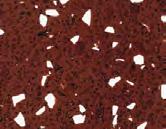

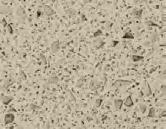


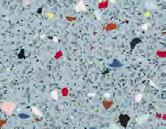
Over the past few years, Durat has invested heavily in in-house research and development. The company is focused on further innovations in solid surface materials. Some key developments include increasing the ratio of recycled materials in production and using its own and other industrial side-

stream materials, which led to the development of an entirely new type of Durat material.
This year, the company introduced DURAT Plus, the world’s inaugural solid surface that merges recycled PET resin with recycled solid surface materials. This innovation results in a uniquely designed solid surface boasting up to 80% recycled content.
“Throughout our company’s history, we continue to strive to be at the forefront of innovation,” said Heikki Karppinen, chief executive officer at Durat. “We do things that we believe contribute to the well-being of our environment. Our actions are guided by existing regulations and in line with our values, and we try to do as much as possible to ensure that our operations are ethically sustainable.” Heikki further explained that Durat has been operating according to the principles of the circular economy since the company’s inception and before the concept was mainstream.
The circular economy is a model aimed at minimizing waste and maximizing resources. It aims to create a sustainable economic system that benefits businesses, society and the environment by reducing waste, lowering carbon emissions and preserving natural resources. Unlike the traditional linear economy, which follows a take-make-and-dispose approach, the circular economy emphasizes the following principles:
• Design out waste and pollution: Products and systems are designed to prevent waste and pollution from the outset.
• Keep products and materials in use: Through practices like reuse, repair, refurbishment and recycling, products and
materials are kept in use for as long as possible.
• Regenerate natural systems: the circular economy goes beyond reducing negative impacts to actively improving and regenerating natural systems.
Key components of the circular economy include:
• Closed-loop systems: Materials are continually cycled back into the economy rather than being rendered to landfills.
• Resource efficiency: Maximize the utility of resources through better design, innovative business models and new technologies.
• Economic and environmental resilience: Reduce dependency on finite resources and minimize environmental impact.
Interior designer and stylist Minna Jones wanted something different for a commercial project encompassing more than 5000 square feet; it was the main venue for 2023’s Helsinki Design Week. “From floor to ceiling, I wanted the spaces to be a complete contrast to the rather colorless hall space,” she explained. “I decided to change my own rules; my approach is usually more restrained and based on neutral colors. In this case, I ended up with bold splashes of color.”
Minna found Durat’s company values and mission aligned with her vision for this project — a perfect fit. “[Solid surface] was already familiar to me, but I hadn’t used it before. We wanted to create a relaxed atmosphere in the spectacular space.” Along with a stage for presentations and exhibitions, the space had Let Me Wine & HDW Bar and the HDW Stage. During the weeklong event, the space hosted various parties, product launches and discussions. Minna said her focus on the design was also modular. “I wanted to design a temporary event space that could be taken apart and completely reused. Minimizing demolition waste is important to me.”
After the event, the furniture was disassembled and delivered back to the Durat to be further recycled, a great example of how this company promotes sustainability at every stage of a project.
To learn more about Durat solid surface and find a distributor near you, visit www.durat.com. C
By Sarah Peiper
Since 2007, GMD Surfaces has become one of Chicago’s premier surface fabricators. The company has a vast inventory, including more than 80 colors, and a quick turnaround program that serves its primary markets of builders and remodelers. The GMD Surfaces team employs cutting-edge technology and strict quality control measures to ensure meticulous craftsmanship.
Owner Omar Chahin immigrated from Syria as a teenager. He comes from a long line of engineers and follows family tradition. He got his undergraduate degree in engineering and layered in a master’s in architecture. “I learned a lot as an architect and established connections with builders and contractors.” But after more than 10 years as an architect and builder, he needed to make a change. “I sensed the housing market was not headed in the right direction,” he recalled. “I decided to sell my remaining inventory of housing lots and reinvest the money in a countertop shop.” He started with three employees, two of whom are still with the company today. “We had a simple bridge saw and one truck.”
Omar credits some of his success to the perspective he gained as an architect, engineer and builder. He didn’t know all the details of surface fabrication and installation, but he had other tools that gave him an advantage. “Architecture is one of the most amazing forms of study,” he explained. “It’s all about problem-solving; it teaches you to think for yourself and to make good decisions. Of course, it’s about spaces and design, but an engineering aspect is at the core.”
It’s also about professionalism, he noted. “When you have a professional background and come to work in this industry, I think you approach things differently. For me, it was never about sell, sell, sell. It’s more about being a resource — establishing trust with clients by answering every question they have. Clients want to work with providers they can trust. If you create that trust, eventually they will buy.” For Omar, word of mouth traveled


from there, and he quickly established an excellent reputation. “It’s about being professional and doing what you’re supposed to do.”
Omar looks back at the 2008 recession with a fondness most in the building and housing industries do not. “It actually gave me a big boost,” he recalled. “We were small and agile; we had low overhead and leaner margins, so we could compete with the big shops. They were just too big to adjust to the times. They had too many processes that became barriers when the market changed. I was fine with a lower margin; they were not. I was negotiable; they were not. I approached it from outside the box while they were trapped inside theirs.”
Omar had created some momentum with his client-centric approach. “A smaller shop owner is willing to compromise and do whatever it takes. Even though I am bigger now, I still operate with that mentality.”
Today, GMD Surfaces has seven installation crews and 42 employees. They serve northwest Indiana and northeast Illinois. They currently work with builders, kitchen and bath showrooms and some retail customers. The fabrication team produces about 15,000 square feet per month. They work with quartz, natural stone, and sintered or porcelain materials, including Dekton.
Offering a variety of materials gives GMD Surfaces a competitive advantage. “We can serve a wider segment of the market,” said Omar. “Every client has different requirements, and
we need to be able to accommodate as many types of projects as possible.” GMD isn’t just doing countertops. They do all kinds of applications like fireplaces, facades and more. “I want to be versatile with our offerings; that also means appealing to every budget,” he explained.
It also means fostering good relationships with suppliers and partners. He approaches those relationships like friendships. Omar stresses the importance of building solid relationships that can weather adversity and the challenges faced in today’s changing landscape.
“In 2022, we were working with a major builder doing 300400 houses a year with what we call level one granite at about $40 per square foot — 5-8 projects per week,” he recalled. “At the start of 2023, they scaled down to 4-5 jobs per month. It was a big hit. I needed higher margins, so I added Taj Mahal quartzite and bought it in bundles to price it at $100 per square foot. Now, I’m keeping my revenue despite volume being down. It was an eye-opening process.” Omar and his team started approaching different classes of builders and adding various levels of materials. “We were quick enough to adjust to create an opportunity.”
Omar says the only slight drawback is that you must take the time to teach your employees the processes working on different types of applications. “How you handle a vertical application is different than a vanity. You have to take the time to teach your employees the processes,” he added. “You have to innovate and find production solutions.”
When Omar started the shop, he did not like how rudimentary it was. Everything was manual. He had an affinity for systems and technology and a lot of great experience with CAD drawings, so he knew there was an opportunity to improve. The first step down the digital path was a Laser Products Industries LT-55 templator. “We needed to be more efficient and accurate, so this was a game changer. It was so precise.”
Because of the economic downturn in 2008, a couple of nearby shops went out of business, and Omar saw an opportunity to make some upgrades. “We acquired some newto-us equipment at a lower cost, including an in-line polisher and our first CNC.” This opened up a path to high-end work that he couldn’t get into before. Since then, GMD Surfaces has continued to grow — one square foot of material in front of the other.


Technology has been the cornerstone of GMD Surfaces’ success. “I knew digital fabrication was the key to optimizing efficiency and accuracy,” he said. “It started with digitizing the most important item: the drawings.” He knew that would get the ball rolling and make way for other modernizations throughout his workflow. “We never looked back.”
Today, GMD Surfaces is running two CNCs, a Saberjet and a Fastback from Park Industries, a dual-bed sawjet and water filtration system from BACA Systems, and they’ve upgraded their LT-55s to the LT-2D3D model.
For workflow management, Omar leans on the latest tech to streamline his operations. His team uses Moraware to manage projects and CounterGo to provide quotes. They use CAD and AlphaCam to run their machines and Slabsmith to manage inventory. “Two years ago, we went paperless,” he said. “Boxes and boxes of files and file cabinets were discarded. We started documenting projects using SPEEDlabel and Job Well Done Dox and Field. We developed shop forms for quality control, field and sales — all digital. They are emailed to the clients for approval and automatically loaded into Moraware using Job Well Done. It was a long and difficult journey but worth it.”
Omar and his team have created machine monitoring software that tracks equipment usage and shop efficiency. “I needed to track downtime and understand why the machines stop,” he explained. “Using this software, you have to input the reason, and the software tracks it. Now we can tell what is happening — identify patterns — and uncover the gaps in our workflow.” The software also creates accountability for the team. Everything is monitored, so there are no secrets behind the downtime.
Omar worked with the University of Illinois Engineering Department to create systems that track his entire workflow. “Four industrial engineering students came in — superusers in Microsoft’s Power BI, Python and more — and together, we created dashboards for accounting, inventory and projects. It is amazing. Now I can see how we are doing relative to the trailing 12 months and project how busy we will be in the near future and long term.” Omar is looking to take this solution to market to help other fabricators improve their workflows.

Offering a variety of materials gives GMD Surfaces a competitive advantage. “I want to be versatile with our offerings; that also means appealing to every budget,” explained Omar.

GMD Surfaces is a member of the Rockheads Group, the International Surface Fabricators Association and the Natural Stone Institute. Last summer, GMD Surfaces hosted ISFA’s Fabricator Crawl.

GMD Surfaces team has dedicated safety meetings and training sessions, and Omar regularly brings in OSHA consultants. He says the consultants have been a big help in improving their safety training and documentation. His team goes through voluntary reviews to make sure everyone is protected.

GMD Surfaces’ most prominent line is MSI’s Q Quartz, and Daltile’s ONE Quartz and Cambria are closely trailing. Residential projects account for 88% of his business, while the rest is commercial, such as restaurants, health care and other public spaces. “We are trying to have a variety of brands and qualities that cater to all clients and budgets. We have a program in our shop that we go to market with — material tiers.”
Omar says it is critical to upsell clients when possible, especially on the retail side, which is only about 20% of his business. They do not have much control over how their partners — kitchen and bath dealers and builders — sell their products and services.
What sets GMD Surfaces apart from the competition is value and service. “We have a great price point for the quality and services we offer,” said Omar. “We are not greedy, and we genuinely care about our clients. Although sales are important, professionalism comes first. If you take care of the client, the sale will follow.”
Omar’s mantra in the marketplace — to take care of the customer — extends throughout his business. “You must take care of your employees,” he explained. “You have to treat them like human beings and provide them with the tools they need to succeed, not just on the job but as people with families and personal lives. Omar sponsors a soccer team that plays in a local league and holds company picnics and other events, fostering camaraderie among the staff while rewarding them for their dedication and hard work. “The more you understand your employees, and they understand you, the more likely they will stick with you. It’s about mutual respect,” he noted.
Regarding safety, the GMD Surfaces team has dedicated meetings and training sessions, and Omar regularly brings in OSHA consultants. He says the consultants have been a big help in improving their safety training and documentation. His team goes through voluntary reviews to make sure everyone is protected. “It’s always transparent and accountable,” he explained. “Every third Thursday, we have a shop meeting. I tell them this is a journey we are taking together. If they agree to follow the procedures, I expect them to do it. Some people are more motivated, and some need reminding, but you have to get them invested in the processes and the reasons behind them. I

approach it from, ‘Look, you agreed that you wanted a safe work environment. I give you all the tools to be safe, so you need to use them. Respect what you told me and be respectful of your colleagues by doing what’s right.’”
There’s also a recruiting aspect to a positive company culture. “Your best marketing to bring new employees is your current employees,” Omar said. “When you give them time and space and respect them, they will attract people with the same values. Investments in my staff — I don’t see that investment as losing money. I look at it as building relationships. It’s cheaper to keep them than invest in new hires.”
For GMD Surfaces, being involved in trade associations and attending industry events has been crucial. “All of the improvements we made as a company were inspired by things we learned at field visits, conferences, seminars and trade shows,” Omar said. “You cannot come up with new ideas sitting behind the desk or simply reading about it. You must go out there and get involved — hear what others are saying, ask questions and see for yourself how they approach challenges.”
Omar is a member of the Rockheads Group, the International Surface Fabricators Association and the Natural Stone Institute. He regularly attends BACA’s Digital Fabrication Seminars, Park Industries’ Digital Stone Expos, TISE and Coverings. He brings
his employees, too. He finds a lot of value in the connections he makes and the knowledge shared, but he also sees the value in what these organizations do to support fabricators and represent their best interests in policy and governance.
“If you’re serious about growing your business and doing the right thing, you must be involved in these associations,” he said. “They are our advocates. There’s no way I can change anything by myself. We need these groups to represent our best interests. That in itself is worth the membership dues.”
What’s next for GMD Surfaces? Omar wants to scale up, and he’s trying to position the business to run by itself. His son has expressed interest in joining the company down the road, so perhaps Omar is building a legacy. But being nimble and eager — those qualities will always remain at the core. “Don’t get complacent; always be hungry,” he recommends. “Having that growth mentality is critical. If the business is growing, it’s not getting old. I don’t want to stop now; I want to grow into different markets.
“I’m ambitious about the future, particularly when it comes to using technology to overcome challenges,” he continued. “I love problem-solving and want to see where that leads me. One of my favorite sayings is, ‘Not all storms comes to disrupt your life; some come to clear your path.’ There is opportunity in everything. The future dictates that we adapt.”
Learn more about GMD Surfaces at www.gmdsurfaces.com. C



By Jason LaMonica, Spec on the Job
While employers in the technology sector might be shedding workers, many in construction, transportation and other bluecollar industries are still struggling to find the people they need. In my experience, blue-collar businesses can fill their ranks and keep them full. Doing so, however, requires a shift in mentality that prioritizes work-life balance, expands these employers’ appeal, and attracts multiple different kinds of workers.
Recent statistics show robust demand for personnel across the American workforce, with the U.S. Chamber of Commerce finding that labor force participation has shrunk over the past two decades. The COVID-19 pandemic triggered a wave of early retirements, and many were forced to abandon the workforce to fulfill caregiving responsibilities.
The upshot is that 6.5 million workers are currently unemployed, while U.S. employers are trying to fill 9.5 million job openings. According to the U.S. Bureau of Labor Statistics, 175,000 roles were created in April alone but is still considered a slowdown from the roaring first quarter when more than 200,000 jobs were created each month.
Businesses in the blue-collar industries are in a particularly tight spot. The Bipartisan Infrastructure Bill created a demand for a historically high average of 20,000 new jobs every month as large infrastructure projects kick into gear nationwide. As a result, construction, transportation and manufacturing companies are feeling the pressure.
Having a lot of work in the pipeline is a good problem to have, but solving it will require companies to adjust. While employers previously enjoyed a great deal of power over employees, today’s workers have more choices. This can be seen in the “Great Reshuffling,” in which workers are changing jobs to take advantage of higher wages, better benefits and more flexible schedules.
In consequence, the old ways of attracting and retaining talent are inadequate to meet the expectations of today’s workers and need to change. Unlimited overtime was once a
big draw for many — the ability to grind extra hours to increase take-home pay — but the next generation isn’t interested in compromising their personal lives to make the salary they expect in a regular workweek. Also, unlimited overtime can indicate to the applicant that the company isn’t managing customer expectations or the production workflow properly, leaving it to their employees to sacrifice nights and weekends to meet demand.
Few workers enjoy being viewed as a mere cog in a soulless machine. I personally have never met anyone who likes being hazed like a recruit at a military boot camp.
Unfortunately, many employers in blue-collar industries have company cultures that rigidly enforce outdated policies. These traditions might have been appropriate at one time, but when it comes to attracting and keeping people under the current conditions, they are not helpful. In fact, they are counterproductive.
For instance, many blue-collar employers continue to resist the idea of offering flexible work hours. According to a 2023 study from Randstad, 42% of blue-collar employees rate flexibility even higher in importance than their wages. Nearly two out of every five workers say their jobs could be done on a flexible basis, but their employers aren’t willing to consider this possibility, and 30% of respondents reported quitting a job because of a lack of flexibility.
Furthermore, employers need to understand that all of their employees have lives and responsibilities outside of the workplace that require understanding and support, which is why they should consider offering child care solutions and flexible hours. This is especially true considering that two-income households are becoming increasingly common in today’s working world. Decades ago, it made sense that employers didn’t need to give their employees the extra flexibility to pick up the kids from school, for example, because there was a stay-at-home parent to handle that. That has changed for today’s workers,
however. Now, employers must ask themselves what concessions they have made for the working mother or father. After all, with over 58% of U.S. households reporting two or more incomes, how are workers meant to manage it all?
Today’s employer-employee relationship should be built on a foundation of mutual trust. It’s not simply an exchange of money for services rendered — it’s a full partnership.
Another complicating factor is that many blue-collar companies lack diversity. According to the U.S. Bureau of Labor Statistics, women have only 10.8% of construction jobs, Black workers hold only 6.7%, and the numbers are even worse for Asian Americans at 1.7%.
At the same time, 90% of the participants in a Simmons University survey say it’s important to feel like they belong in their workplace. Zero respondents said it wasn’t important at all.
The fact that most blue-collar teams are predominantly made up of white men contributes to employers’ problems. It is not unreasonable for prospective employees from marginalized demographics to wonder if they would fit in, nor for them to question if the company’s culture is actually as inclusive as it might claim to be.
Indeed, research has shown that many blue-collar companies have toxic cultures that make women quit for good reason. In a 2021 poll conducted by the Institute for Women’s Policy Research, nearly 25% of women in the trades reported “always or frequently” facing sexual harassment at their workplace.
The Wall Street Journal reports that, according to the U.S. Equal Employment Opportunity Commission, many bluecollar workplaces allow inappropriate jokes, conversations and imagery to circulate unchallenged. In contrast, women who report problems to supervisors have their complaints minimized and dismissed.
This needs to change. Filling the ranks will require employers to start appealing to and actually supporting people

from traditionally underrepresented demographics, which means getting serious about diversity and inclusion efforts. Managers need to push back on outdated, chauvinistic, racist, or other exclusionary attitudes and clean up bad behavior that perpetrators might never have been held accountable for in the past. The slightest whiff of bias, discrimination or harassment should be stamped out.
Blue-collar industries can also find real opportunities to recruit people from younger generations. Members of Gen Z are wary of the high price of college tuition and are more willing to consider the trades than their predecessors, especially because they have now seen how AI has threatened certain white-collar roles. That’s why enrollments at vocational and technical schools have increased, while those at traditional liberal arts colleges have remained relatively flat, as numbers from the National Student Clearinghouse Research Center show.
The good news is that when blue-collar companies foster a culture that leads to happier employees, it helps not only the workers but also the businesses themselves.
According to researchers at the University of Oxford, when someone is happier, they work faster, which translates into more positive outcomes such as increased sales. Indeed, the authors conclude that happier employees perform 13% better than their less happy colleagues.
In my experience, employees with greater job satisfaction also tend to be more loyal to their employers. Studies also back this up, noting that employees feel the most loyal to workplaces where they feel valued.
Blue-collar companies that embrace change will see positive results in return. Inclusive company cultures in which people are treated like the human beings they are and receive support are better for everyone. These are also the best ways for companies to thrive. C
Jason LaMonica is the chief operating officer of Spec on the Job, and he brings more than 15 years of experience to blue-collar staffing and leadership. He ensures stability and growth for these service lines with a focus on operational excellence within three key areas: evidence-based best practice programs, well-trained and appropriate staffing of people and developing key partnerships with clients. To learn more about Spec on the Job and blue-collar staffing solutions, visit www.speconthejob.com.
2
By Wendy Christie, owner and founder of EmployerESource
The world of human resource management is a lot different today than just a few decades ago. One space that has seen the most change — and is still changing — is onboarding.
In the early years of my career in human resources, the onboarding process was rudimentary at best. The process usually involved handing out stacks of payroll forms to new employees and showing them to their desks. At the time, getting an employee handbook or a formal introduction to your new supervisor was a luxury. Recruits back in the day were thrown into the deep end of the job without much preparation.
Things couldn’t be any more different today.
According to a 2022 Gallup poll, 54% of Generation Z employees are ambivalent or disengaged. This has bred a generation of employees with very little interest in their jobs and no problem leaving their jobs at the slightest inconvenience; gone are the days of employees sticking to a job.
Handling the new generation of employees requires a different approach to onboarding — an approach that focuses on engagement right from the first day of employment.
When considering today’s employees, particularly those from the millennial and Z generations, it’s crucial to acknowledge that many of them were raised by “helicopter parents” who excessively monitored and intervened in their lives. This parenting style has resulted in the emergence of two generations often characterized as the most demanding and needy of our time.
Managing these employees is no easy feat and requires a different onboarding and orientation approach. With the right employee program, human resources personnel can increase employee retention and develop a dynamic team environment
best suited for engaging this generation.
Building a team of employees in this generation requires more than an orientation program; today, it’s about an employee integration program. Such a program should encompass several key components to integrate new hires into the company effectively.
Here are four pillars that can help you build a successful, engaged team:
Your onboarding process should start with an orientation process that introduces each new employee to the big picture of the company’s operations, including mission, vision and values. Today’s employees want to be engaged and feel like what they are doing matters, so let your integration process do just that.
Take new employees around the company to give them an overview of how the entire operation works. Then, provide a more detailed tour of their specific department to give them a better understanding of how they fit into that big picture. When done right, this simple step can help your employees understand how they fit within the company and that what they do for the company is important — and, by extension — makes them feel valued.
According to Gallup research reports, a friendly work environment increases employee retention. When employees make meaningful connections at work, it can drastically improve job success.
Creating an integration process that fosters camaraderie
in the workplace can help you achieve this. Make an effort to introduce new employees to others who share common interests and encourage employees to build connections with one another as part of your company culture.
Mentorship is integral to effective career development, something practically every employee values. According to a recent CNBC workplace happiness survey, more than 91% of employees who are active in a mentorship program are satisfied with their jobs. More than 57% are very satisfied. Introduce a mentorship in your integration process. During orientation, identify experienced colleagues who can guide your new employees if they need help or have questions. Mentorship programs are also a great way to help new employees learn new skills, gain more experience and grow in their roles.
Traditionally, mentorship programs are directed at employees looking to put in the extra work to climb up the corporate ladder, but your strategy here is to introduce and make it available to everyone right from the get-go. Doing this will enhance employee satisfaction and retention and contribute to a positive company culture where knowledgesharing and collaboration thrive.
Mentorship programs can be a very effective tool for

improving job satisfaction and employee retention, but they can also go very wrong when not done correctly. Human Resources’ job doesn’t stop at creating the mentorship program; it’s important to curate the program to ensure its success.
While there are various mentorship programs you can adopt, you’ll want to ensure that the program you choose is ideal for your company and then customize that to fit your current recruitment’s unique needs.
You’ll also want to choose the ideal mentor for your recruits. When selecting mentors, choose someone knowledgeable about their field and optimistic about the company. Remember, the goal here is to improve employee retention as well. Check in on mentees and mentors regularly to ensure that the partnership is going smoothly. Sometimes, certain mentors might not be a good fit for certain recruits.
Realizing this early can help prevent disaster down the road. Don’t be afraid to connect a mentee with a different mentor as situations and needs change.
Wendy Christie, owner and founder of EmployerESource, has over 20 years of experience in employee relations. EmployerESource is a software program that develops a company handbook based on company requirements, state law, federal law and industry practices. As a human resource consultant, Wendy helps companies develop legally compliant employee handbooks and documentation, and she has handled over 100 different employee relations investigations. Learn more at www.employeresource.com.
Off-hand onboarding programs don’t work well with today’s younger employees. The trick lies in employee engagement. Creating an engaging environment for these employees, one that fosters camaraderie, trust and knowledgesharing, is going to be more critical than ever as the values of our industry’s employees shift to more personal fulfillment and growth. C C C C A A A A B B B B 2 2 2 D V V V V


By Marissa Bankert, ISFA Chief Executive Officer
I get it. Sometimes, when we think about sales, it conjures up images of someone whose sole goal is to get one over on us. The truth is: We are selling ourselves and our brands every day in what we create, who we interact with, and showing them why we are great! With that in mind, here’s my best sales pitch on why YOU should plan to attend the International Surface Fabricators Association’s 2024 Annual Conference scheduled for November 6-8 in Miami.
Let’s start with our goal: We want every fabricator who attends to leave with three key elements. The first is making a new key contact. The ISFA Annual Conference is an opportunity to meet with other fabricators from throughout the world and connect with our associate partners. The chance to learn from peers is a crucial factor in success. Knowing that you can speak to those committed to the industry and learn from their trials and tribulations is one outcome that we expect for all attendees.
The second key element attendees can expect to gain is knowledge. We will have educational sessions on topics that are pivotal to furthering the industry, including best practices in fabrication techniques and business management and safety concerns. This year’s Fabricator Forums have included presentations on silica safety, understanding your OSHA rights, using artificial intelligence to increase productivity, fleet management and marketing. You might see those topics
on the Annual Conference agenda, along with follow-up presentations from some of our Behind the Surface podcasts and MemberConnect events.
The third and final goal is for our members to have some fun! This is your chance to celebrate your 2024 successes with your peers. We will have a meeting highlighting all we have accomplished in 2024 and look forward to 2025 with you. We will celebrate ISFA Award nominees and winners by highlighting great projects and the outstanding member companies and individuals who shine throughout the surfacing industry. We will dedicate time with our associate partners to meet them with the common goal of enjoying time together. We will have sun, surf and Miami nights to enjoy.
These are just pieces of what I hope will be a new start for ISFA in reestablishing our association in the surfacing landscape as a valued resource. Your attendance, ideas and participation are a part of that vision. We need new and seasoned voices. We need contributors to attend educational sessions, eager with questions and conversation starters. We need people who are willing to connect with others to help grow the industry. In short, WE NEED YOU!
There’s my sales pitch for the 2024 Annual Conference. We look forward to an engaging and informative event and having you join us as a foundational part of the new ISFA. Are you ready to innovate, fabricate and dominate the industry with us?

ISFA will hold a Porcelain Fabrication Training Event September 26-27 in Austin, Texas. Hosted by Alpha Granite & Tile and sponsored by BB Industries, Daltile and Integra Adhesives, the training is designed to arm fabricators with the knowledge and skills they need to meet growing customer demand. Porcelain continues to rise in status as consumers seek alternatives to quartz and granite.
The hands-on, two-day training will provide attendees with skills and knowledge in all facets of the fabrication process, including material handling and inspection, cutting techniques (feed rate, blade recommendations, tension release cuts), sink cutouts, miters, overhangs, seaming, polishing and finishing, installation, and chip and scratch repair
techniques.
“Fabricators founded our association to provide educational and growth opportunities for professionals within the industry,” said Marissa Bankert, chief executive officer of ISFA. “Our training programs are a great way to train new hires, get familiarized with emerging materials, and gain valuable insights that lead to safe and successful operations.”
In addition to Porcelain Fabrication Training, ISFA offers Solid Surface Fabrication Training events throughout the year. The next Solid Surface Fabrication Training event is scheduled for October 22-23 in Boston.
For more information about ISFA’s fabrication training programs, visit www.ISFAnow.org.
Previously known as Industry Roundtables, Fabricator Forums help members access the information and resources they need to tackle business challenges and establish valuable relationships. After a successful spring Fabricator Forum in Charlotte, North Carolina, ISFA looks forward to hosting fabricators September 11-12 in St. Louis.
Sponsored by BB Industries and Vicostone, this two-day event will cover:
• Silica safety.
• Staffing and employee management strategies.
• Fleet management.
• Marketing strategies.
• Quartz cleaning and care techniques.
On the second day, attendees will visit local fabricator
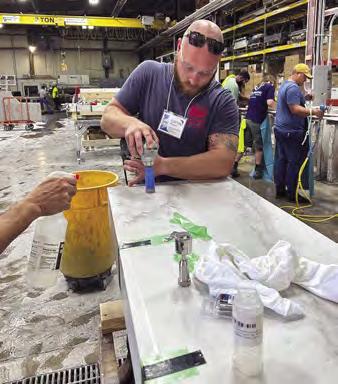
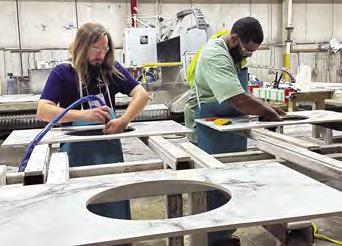
Custom Marble for a shop tour. The visit will also include an OSHA presentation, “Know Your OSHA Rights,” designed to inform fabricators about common compliance issues and how they can mitigate risk.
“ISFA is looking forward to bringing this popular event to St. Louis,” said Marissa Bankert, executive director of ISFA. “Fabricator Forums are designed to be well-rounded opportunities that provide attendees with the resources they need to overcome challenges and grow their businesses, and the programming reflects the needs of today’s fabricators.”
ISFA Fabricator Forums are open to all fabricators, including nonmembers. Visit www.ISFAnow.org/fabricatorforums for more details and to register. Space is limited, so those interested in attending are encouraged to reserve their spot as soon as possible.
Spenard Builders Supply Anchorage, A laska
Toor Stone Countertops Austin, Texas
WL Stone Works Chicago
C &M Cabinets and Granite Collierville, Tenn.
K itchen Creations Deatsville, Ala.
MOD Eugene Cabinetry Dexter, Ore.
J&L Custom Countertops Duncanville, Ala.
Stone Crafters
Egg Harbor Township, N.J.
ShowFab Fairfield, N.J.
Yellowstone Marble & Granite Houston, Texas
W TB Woodworking Huntingdon Valley, Pa.
Stone Creation Irvine, C alif.
Sprovieri’s Custom Counters Addison, Ill.
The Granite & Marble Depot Aurora, Ill.
C arefree K itchens Baltimore, Md.
Integrated Manufacturing Barrigada, Guam
Surfaces by Tex-San Boerne, Texas
Spaulding Fabricators Brick, N.J.
Unique Countertops Buda, Maine
T he Granite Place Burlington, Maine
Melling Granite Cedar City, Md.
ISFA P.O. Box 627
Ingomar, PA 15127
888-599-ISFA www.ISFAnow.org
Chief Executive Officer
Marissa Bankert
717-253-5296 Marissa@ISFAnow.org
Harkey Tile & Stone Charlotte, Md.
Granite E xpressions DuBois, Md.
Quality Cabinets and Counters Fort Myers, Fla.
Top Advantage Surfaces Hartville, Md.
Innovative Surfaces Hastings, Minn.
INDEKO Henderson, Nev.
Galaxy Granite & Marble Hopkinton, Md.
Countertop Source Hurricane, Utah
Smokey Mountain Tops Knoxville, Tenn.
Membership Director Heather Duve 888-599-ISFA Heather@ISFAnow.org
Marketing and Communications Director Sarah Peiper 888-599-ISFA Sarah@ISFAnow.org
Florida Custom Marble Jacksonville, Fla.
Granite Concepts Lewiston, Idaho
Trademark Universal Stone Louisville, Ky.
Keystone Granite Oak Bluff, Canada
Halifax Flooring Orem, Utah
Stockett Tile & Granite Phoenix, AZ
Kodiak Building and Maintenance Kodiak, Alaska
Bella Casa Countertops and Stone Littleton, Md.
GMD Surfaces Mokena, Ill.
Rosskopf + Partner Nottertal-Heilinger Heights, Germany
Mill-Rite Woodworking Company Pinellas Park, Fla.
T he Pinske Edge Plato, Minn.
Delorie Countertops & Doors Pompano Beach, Fla.
Great In Counters Providence, R.I.
Project Coordinator Samantha Winslow 888-599-ISFA Samantha@ISFAnow.org
Web/Database Administrator Amy Kyriazis 412-487-3207 Amy@ISFAnow.org
CRM StoneWork Prairieville, La.
San Luis Marble
Santa Maria, Calif.
Soniat Cabinets & Millwork St. Rose, La.
Granit Design Stanstead, Canada
Stone Central Summerville, S.C.
Reading Hospital West Reading, Pa.
Atlantic Countertops Raleigh, Texas
New Age Surfaces Romeoville, Ill.
W.R. Watson Stafford, Texas
Curtis David Interiors Stanwood, Md.
Hard Rock Stone Works Sterling Heights, Md.
Valley View Granite Tremonton, Utah
Precision Countertops Wilsonville, Md.
FLOFORM Countertops Winnipeg, C anada
Heyboer & Bolt Wyoming, Mich.
Administrative Assistant Kanani Camacho 888-599-ISFA Kanani@ISFAnow.org
Sponsorship opportunities are available for qualifying manufacturers, distributors and other industry-related companies. These businesses are dedicated to the success of the International Surface Fabricators Association and fabricators everywhere. Through their contributions, sponsors enable ISFA to create meaningful opportunities for its membership including training, education, business development, networking and more.






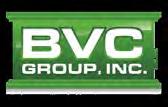











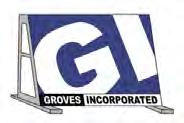

ACS International 4775 South 3rd Ave. Tucson, AZ 85714 520-889-1933 www.acstone.com
Aetna Building Solutions 1401 St. Charles Rd. Maywood, IL 60153 708-343-1515 www.aetnaplywood.com
Akrilika Ul. Szczepankowice Male 2A 55-040 Wierzbice Poland 79119451961 www.akrilika.com
Aristech Surfaces (Avonite) 7350 Empire Dr. Florence, KY 41042 859-283-1501 www.aristechsurfaces.com
Al-Badaha Company for Modern Industries P.O.Box 126444 Jeddah, Saudi Arabia 966920002964 www.albadaha.com
BACA Systems
101 Premier Dr. Orion Township, MI 48359 248-791-3060 www.bacasystems.com
BB Industries
4100 Appalachian Way Knoxville, TN 37918 800-575-4401 www.bbindustriesllc.com
Better Vacuum Cups 13841 Roswell Ave., Ste. K Chino, CA 91710 877-379-9909 greenbvc.com
Biesse America
4110 Meadow Oak Dr. Charlotte, NC 28208 704-357-3131 www.biesse.com
BNP Media
2401 W. Big Beaver Rd., Ste. 700 Troy, MI 48084 248-362-3700 www.bnpmedia.com
Breton S.p.A.
Via Garibaldi, 27 Castello di Godego 31030 Italy 3904237691 www.breton.it/en/
Bronwick Recruiting 7700 Basil Dr. Austin, TX 78750 512-981-5294 www.bronwick.com
Caesarstone US
1401 W. Morehead St. Charlotte, NC 28208 818-378-2667 www.caesarstoneus.com
Cambria USA 31496 Cambria Le Sueur, MN 56058 507-665-5003 www.cambriausa.com
CaraGreen 1406 Transport Dr. Raleigh, NC 27603 919-929-3009 www.caragreen.com
Chemcore Industries
5311 Fleming Ct. Austin, TX 78744
866-243-6267 www.chemcor.com
Chemical Concepts 410 Pike Rd.
Huntingdon Valley, PA 19006 800-220-1966 www.chemical-concepts.com
Colonial Saw 122 Pembroke St. Kingston, MA 02364 781-585-4364 www.csaw.com
Compac USA
1777 NW 72nd Ave., Unit 2 Miami, FL 33126 305-406-3600 www.us.compac.es/quartz/
Cosentino USA
355 Alhambra Cir., 10th Floor Coral Gables, FL 33134 786-812-0509 www.cosentino.com
Countertop Marketing Co. 402 Pequot Ave. #772 Southport, CT 06890 203-993-6676 www.countertopmarketingco.com
Covia Corp 9930 Kincey Ave., Ste. 200 Huntersville, NC 28078 800-243-9004 www.coviacorp.com
Dal-Tile Corporation
7834 CF Hawn Frwy. Dallas, TX 75217 214-309-3162 www.daltile.com
Doyle Farris (Bellavati) 6606 FM 1488, Ste. 148-517 Magnolia, TX 77354 859-533-3079 www.doylefarris.com
DuPont (Corian Design) 200 Powder Mill Rd. Wilmington, DE 19803 314-941-5179 www.corian.com
Durasein USA 7030 Quad Ave., Ste. 3 Rosedale, MD 21237 877-771-7712 www.durasein.com
Durcon 206 Allison Dr. Taylor, TX 76574 512-595-8000 www.durcon.com
Dwyer Marble & Stone Supply 23177 Commerce Dr. Far mington Hills, MI 48335 248-476-4944 www.dwyermarble.com
Easededge
907 Jesuit Ln. St. Marys, KS 66536 785-202-3070 www.easededge.com
Elevated Industrial Solutions 2050 W. Barberry Place Denver, CO 80204 303-908-9095 www.lanesupplycompany.com
Emnas Technologies
347 Ferndale Dr. South Barrie, ON L4N 9Y6
647-302-3630
www.emnastech.com
Evans Midwest
11441 E. Lakewood Blvd. Holland, MI 49424
616-546-8225
www.evansmidwest.com
Fabricator’s Business Coach
309 Gassaway St. Central, SC 29630-9197
864-328-6231
www.fabricatorscoach.com
Federal Brace
710 E Catawba St., Ste. A Belmont, NC 28012
877-353-8899
www.federalbrace.com
Fifth Gear Technology (Speed Label)
450 N. Addison Ave. Elmhurst, IL 60126
630-606-8055
www.speedlabel.net
FreePower
2048 N. 44th St. Phoenix, AZ 85008
914-227-3435
www.freepower.io
GEM Industries
5030 N. Hiatus Rd. Sunrise, FL 33351
954-749-1228
www.gem-industries.com
Gemstone
2040 Industrial Pkwy. Elkhart, IN 46516-5411
574-294-8899 www.gemstonesinks.com
Grand Onyx
134 West South Boundary St. Perrysburg, OH 43551 567-686-1040 www.grandonyx.pro
Granite Gold
12780 Danielson Ct., Ste. A Poway, CA 92064
858-499-8934
www.granitegold.com
GranQuartz
3950 Steve Reynolds Blvd. Norcross, GA 30093
800-458-6222
www.granquartz.com
Groves Incorporated
818 Trakk Ln. Woodstock, IL 60098
815-337-9780
www.groves.com
Hallmark Building Supplies
901 Northview Rd., Ste. 100 Waukesha, WI 53188 800-642-2246 www.hllmark.com
Hyundai L&C USA
2839 Paces Ferry Rd., Ste. 1100 Atlanta, GA 30339 888-426-9421 www.hyundailncusa.com
Ignite Consulting Group (Hot Sauce Selling Software)
450 N. Addison Ave. Elmhurst, IL 60126 630-606-8055 www.hotsauceyourtops.com
InnoChem/Akemi 160 Candlewyck Dr. Avondale, PA 19311 www.akemi.com
IPS Adhesives LLC (Integra Adhesives)
455 W. Victoria St. Compton, CA 90220 919-598-2400 www.integra-adhesives.com
Jaeckle Distributors 4101 Owl Creek Dr. Madison, WI 53718 608-838-5400 www.jaeckledistributors.com
Karonia Surfaces
Ansym Lodge, Water Ln. Eggborough, GOOLE DN14 0PN United Kingdom 447814415724 www.karonia.com
Karran USA
P.O. Box 667 1291 East Ramsey Rd. Vincennes, IN 47591 410-975-0128 www.karran.com
Kohler Co. P.O. Box 899 Kohler, WI 50344 920-457-4441 www.kohler.com
Lapitec Via Bassanese 6 Vedelago, Treviso 31050 Italy www.lapitec.com
Laser Products Industries 1344 Enterprise Dr. Romeoville, IL 60446 630-755-5402 www.laserproductsus.com
LOTTE Chemical
6 Centerpointe, Ste. 100 La Palma, CA 90623 714-443-0901 www.lottechem.com
LX Hausys America 900 Circle 75 Parkway, Ste. 1500 Atlanta, GA 30339 678-535-4113 www.lxhausysusa.com
Material+ 1900 Avenue of the Stars Ste. 1600, 19th floor Los Angeles, CA 90067 www.materialplus.io
Milia Marketing 2515 Jay Ave., Unit 101 Cleveland, OH 44113 216-990-5250 www.miliamarketing.com
Moksh Tech #1204, Pushpak Landmark Bldg. Near Titanium City Center Anand Nagar Rd. Prahlad Nagar Ahmedabad - 380 015 India 301-252-2673 www.mokshcad.com
Moraware 13125 Welcome Way Reno, NV 89511 866-312-9273 www.moraware.com
MSI Surfaces 2095 N. Batavia St. Orange, CA 92865 www.msisurfaces.com
National Institute for Occupational Safety and Health
1095 Willowdale Rd., MS-2800 Morgantown, WV 26505
www.cdc.gov
Natural Stone Institute
380 E. Lorain St. Oberlin, OH 44074 440-250-9222 www.naturalstoneinstitute.org
Ollin Stone
301 E. Ball Rd. Anaheim, CA 92805 714-535-0800 www.ollinstone.com
Park Industries
P.O. Box 188 St. Cloud, MN 56302 320-251-5077 www.parkindustries.com
Parson Adhesives (Chromalok)
3345 Auburn Rd., Ste. 107 Rochester Hills, MI 48309 248-299-5585 www.chromalok.com
Poseidon Industries
4080 Duncan Rd. Punta Corda, FL 33982
Prodim Systems
7454 Commercial Cir. Ft. Pierce, FL 34951 772-465-4000 www.prodim-systems.com
Quote Countertops
11811 N. Tatum Blvd., #3078 Phoenix, AZ 85028
619-726-7660 www.quotecountertops.com
Rockheads Group
1401 Lavaca St. #1146 Austin, TX 78701 815-210-1006 www.rockheadsusa.com
Sage Surfaces
6700 The Woodlands Pkwy., Ste. 230-303 The Woodlands, TX 77382 837-403-2847 www.sagesurfaces.com
Schechner Lifson Corp.
4 Chatham Rd. Summit, NJ 07901
908-598-7813
www.slcinsure.com
Schultz Forming Products
2796 Loker Ave. W., Ste. 105 Carlsbad, CA 92010
800-822-2875 www.schultzform.com
Shlok TeQ
1364 E. US Hwy 377 Granbury, TX 76048 325-313-6090
www.shlokteq.com
Slab Caddy
5949 American Rd. E Toledo, OH 43612 419-726-7400 www.slabcaddy.com
SolidSurface.com
6641 N. Cibola Ave. Tucson, AZ 85718
520-247-3304
www.solidsurface.com
Stone Grid (StoneApp)
452 Osceola St., Ste. 211 Altamonte Springs, FL 32701 877-909-0569 www.stonegridusa.com
Stone Update
1775 E Palm Canyon Dr, Ste 110 #193 Palm Springs, CA 92264
760-323-9554 www.stoneupdate.com
Synchronous Solutions
3405 Rainbow Dr. Waxhaw, NC 28173
704-560-1536 www.synchronoussolutions.com
Taffy Events (Coverings)
2300 Clarendon Blvd., Ste. 305 Arlington, VA 22201
301-774-7739 www.taffyeventstrategies.com
Total Stone Solutions
45237 Grand River Novi, MI 48375
248-804-1408 www.total-stone.com
Tile Council of North America
100 Clemson Research Blvd. Anderson, SC 29625 601-506-1609 www.tcnatile.com
Triton Stone Group 6025 W. 80th St. Indianapolis, IN 46278 317-644-1200 www.tritonstone.com
US Surfaces
4601 Spicewood Springs Rd. Bldg. 1, Ste. 100 Austin, TX 78759 512-454-2229 www.ussurfaces.com
Vicostone USA 11620 Goodnight Ln., Ste. 100 Dallas, TX 75229 972-243-2325 www.us.vicostone.com
Water Treatment Solutions 6 Merrill Industrial Dr. Hampton, NH 03842 603-758-1900 www.watertreatmentonline.com
Web-Don
1400 Ameron Dr. Charlotte, NC 28206 800-532-0434 www.web-don.com
Willis
1149 Pioneer Rd. Burlington L7M 1K5 Canada 289-775-5814 www.4willis.com
Wilsonart
2501 Wilsonart Dr. P.O. Box 6110 Temple, TX 76503-6110 800-433-3222 www.wilsonart.com
Wood Stock Supply
4705 S. I-90 Service Rd. Rapid City, SD 57703 605-341-6900 www.woodstocksupply.com
ZOLLER
3900 Research Park Dr. Ann Arbor, MI 48108 734-332-4851 www.zoller-usa.com

EARTHIC by SilestoneXM fuses together unconventional and reclaimed materials to create a sustainable surface concept that sets a new benchmark for the industry. Developed in collaboration with the iconic Italian studio Formafantasma, EARTHIC reinforces Cosentino’s long-term commitment in the effort to become a more sustainable company, and continues to pave a path to tangibly minimize the impact of surfaces in the future.
EARTHIC is a capsule collection that offers a new concept design, with an advanced composition of up to 30% recycled materials, including recycled glass, PET, bio-resin and Dekton fragments. Moreover, when manufacturing the surfaces, post-consumer bio-resin (between 16% and 23%) derived from vegetable oil and recycled cooking oil is used, as well as plastic bottles, which are transformed into distinctive scales that reveal their unique characteristics on the surface.

EARTHIC is divided into two color series; shown here is Raw D, featuring a dark natural rock backdrop that provides a mood of tranquility and solid elegance. Diffused streaks of bronze weaves through a charcoal landscape. To see all the new designs, visit www.cosentino.com/usa/silestone-xm/earthic/.
In the realm of Vadara Quartz’s latest innovations, Safari Delta stands out as a testament to the beauty and complexity of Botswana’s Okavango Delta. This new design captures the essence of the river’s lifelines, with each channel sculpting the wilderness into a vivid tapestry of life. Safari Delta’s striking taupe and brown veins traverse a radiant white backdrop, presenting a modern twist on classic marble infused with the untamed spirit of the wild. The design mirrors the dynamic heartbeat of the African landscape, where the rhythmic flow of water dictates existence. Bringing this blend of drama and tranquility into your space, Safari Delta promises a bold yet natural aesthetic that resonates with the raw elegance of the Okavango. Visit www.vadaraquartz.com/new-designs for more information.
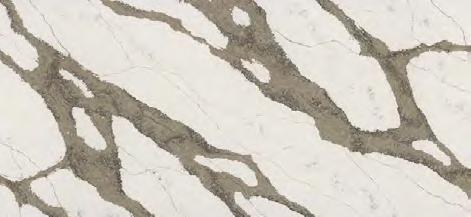
Wetwall, a Wilsonart Company, announces the launch of its new Pro Plus Collection, designed specifically for larger-scale commercial projects. Offering unparalleled efficiency, durability and aesthetic appeal, the Pro Plus Collection is set to revolutionize the way commercial spaces are designed and constructed. This innovative collection features 11 designs inspired by nature that beautifully mimic the looks of marbles, woodgrains and more.
Ideal for projects requiring at least 9,700 square feet of material with a half truckload order minimum, the Pro Plus Collection is engineered to meet the demands of modern commercial construction. From new builds to renovations, the collection offers a superior alternative to traditional tile solutions. The total start-to-finish price for materials, time and labor is significantly less than tile, making it a costeffective choice for budget-conscious projects.

Ideal for shower walls, bath surrounds, accent walls and cladding, Wetwall features a simple tongue-and-groove installation system on panels that can be easily installed with no special tooling required. Created with a patented, waterproof core and antimicrobial protection that inhibits the growth of stain- and odor-causing mold and mildew, Wetwall panels are engineered to withstand everyday use with little maintenance required. The system additionally features AEON Enhanced Scratch and Scruff-Resistant Performance Technology, giving it superior durability and ease. Wetwall is GREENGUARD Gold Certified to meet low chemical emission limits for better indoor air quality. For more information, visit wetwall.com.

LX Hausys America introduced the new VIATERA Suprema Collection. Each color in the collection is defined by its extremely subtle, thin veins. The three new colors are Calacatta Suprema, Suprema Carmela and Suprema Nero, which is pictured here.
Suprema Nero is available in a polished finish and draws inspiration from the timeless Italian Calacatta marble, seamlessly blending deep charcoal veins with a pure white canvas. The design captures the graceful interplay of light and shadow, establishing an ambiance of tranquility and sophistication.
All three Suprema Collection colors are made in America with U.S. and imported parts. The colors are available in a 63-inch by 130-inch slab size, with options of 2 cm and 3 cm thicknesses. The products are backed by LX Hausys’ 15-year limited warranty. See all the new designs at www.lxhausys.com/us/products/viatera-quartz-surface.
Three of Neolith’s latest low-silica surfaces have landed in the U.S. and are now available across the country. Cappadocia Sunset evokes the textures, movement and dynamism of the Turkish region, without compromising elegance, neutrality in color and balance that can be expected in a Neolith product. Calacatta Roma dazzles with the combination of ocher and gray veins on the white background, which gives sobriety and elegance to this interpretation of Carrara marble. Available in silk finish, Everest Sunrise, pictured here, is an impeccable and perfectly balanced quartzite, ready to illuminate every space. The combination of delicate and peaceful color with a subtle sparkle and shine of gold transmits adventure, elegance, exclusivity and purity.

Neolith is a world leader in the design and manufacture of low-silica sintered stone surfaces. Sintered stone is an innovative building material that stands out for its advantages in terms of strength, durability, design and sustainability. Neolith surfaces are made of 100% all-natural raw materials and are highly versatile and functional. They can be used for applications such as kitchen countertops, bathroom shower walls, shower trays and vanities, cladding, facades and furniture. The surfaces are easy to clean, ultrahygienic and UV resistant, making the surface suitable for both indoor and outdoor settings. Learn more at www.neolith.com.

With a commitment to impeccable detail and quality, Caesarstone launches its new OOAK (One of a Kind) Quartz and Porcelain Collection, a celebration of the unrepeatable nature of veining. Each surface is designed with purposeful elements, movement and depth. Create your One-of-a-kind space with your own personal style, a space that inspires you to create extraordinary moments.
Marbannova is a porcelain surface that showcases a luxuriously silky warm white, made tactile by the dynamic rush of hushed gold, taupe and gray lines that dissolve into a translucent sedimentary cloud, heightened by a velvety feel and an uplifting light in soft Silk finish. It is available in a 12-mm thickness in a jumbo slab size measuring 124.5 inches by 61.5 inches.
Goldfinch is a quartz material that dazzles with gilded veins that sweep across a pure white base, undulating in a dense mesh of warm earthy alloys accentuated by neutral oxides and gradations of burnt amber, echoing the shifting sands of a wind-blown landscape. It is available in 20-mm and 30-mm thicknesses in a jumbo slab size measuring 130 inches by 64.6 inches.
To see all the new designs, visit www.caesarstoneus.com.

By Ted Sherritt, ISFA President
Webster defines trade associations as “an association of tradesmen, businessmen, or manufacturers in a particular trade or industry for the protection and advancement of their common interests.” In the case of the ISFA, we comprise all three groups, but our priority is our tradespeople — our fabricator members.
ISFA’s mission is to promote the surfacing industry through education, standards, resources, camaraderie and safety; our vision is to be recognized as the expert and authority serving the fabricators and professionals of the surfaces industry. We value innovation, dependability, integrity and serving others.
ISFA brings fabricators, installers and vendors together to share best practices, embrace innovations and build meaningful relationships. We are a community dedicated to practical learning, collaborative solutions and advancing the industry. We are your gateway to a network that transforms competition into collaboration.
A perfect example of this commitment to our fabricators is the work ISFA and the Natural Stone Institute (NSI) are doing to protect the industry from overbearing governmental regulations in California regarding silica safety. The issue is real; workers are getting sick due to unethical and unsafe business practices in a few regions of the state. These new regulations could significantly impact how all companies in North America operate, even if they are not experiencing employee health issues. California’s fabrication safety regulations will be studied and used as a model (if not adopted outright) by other states in the United States. I urge you to pay attention to what is happening in California and stay informed on this issue. It is imperative for your business’s long-term success and the safety of your employees.
ISFA and NSI are working on education and awareness programs that will form part of the employee safety framework used in California regulations going forward. Countless hours of work on fabricators’ behalf have been invested to ensure the regulations protect our workers without putting an undue and unstainable burden on the fabrication industry. It’s been
a balancing act and is far from complete, but we are making progress.
And even though AB 3043 is on hold for 2024, it’ll resurface in 2025, so we continue to advance our charge by:
• Gathering scientific evidence that supports or refutes the use of National Institute for Occupational Safety and Health rules around Permissible Exposure Limits and Action Levels with respect to air quality and worker safety.
• Clarifying and reviewing the current literature on silicosis.
• Educating the governing bodies that make the regulations.
• Developing and delivering silica safety training.
• Educating all industry professionals about the effects of respirable crystalline silica and its direct link to silicosis.
To advance and protect our industry, we must keep charging ahead. ISFA is fortunate to have a great complement of staff to tackle some of these tasks, and we are grateful for their dedication to our membership. In addition, our association is governed by a volunteer board of directors that comprises 15 fabricator and associate member partners. This volunteer board oversees ISFA through newly adopted processes that adhere to the Entrepreneurial Operating System while referring to a strategic framework and accountability chart. We participate in monthly meetings — virtual and in person — and take on additional tasks as needed.
To advance and protect the surfacing industry, we need an active and participatory board to lead the cause. It is that time of year when we scout for new voices, new perspectives and stewards of our industry. Maybe that’s you — a dedicated individual who wants to help govern ISFA and thereby impact the trajectory of our industry.
If you are interested in serving on ISFA’s board of directors, please reach out to our CEO, Marissa Bankert, or me to learn how you can serve. As Margaret Mead said so well, “Never doubt that a small group of thoughtful, committed citizens can change the world; indeed, it’s the only thing that ever has.”

